




By Sheree R. Curry Contributing Writer
or Portia Jackson, a mother of five, the concept of “home” was once elusive.
“I lived on friends’ couches, cousins’ floors, neighbors’ threeseason porches, homeless shelters, rundown motels, and transitional housing,” Jackson recalled about her childhood. “I always longed for permanency.”
She eventually found a path forward after connecting with the Jeremiah Program (JP), a national organization dedicated to disrupting the cycle of poverty for single mothers and their children two generations
at a time by supporting them to achieve economic mobility and long-term success.
One of JP’s services is providing affordable housing options, either through its own residential buildings or by partnering with community organizations. “After 20-plus schools, three states, and several cities, I was finally afforded the opportunity for housing stability,” Jackson said. Through JP’s network, she said she secured an apartment for herself and her young children. “As long as I followed the rules, no one could take it from me.”
It’s been over 25 years since Jackson first walked through
the JP doors. It was there that she acquired the tools to build a foundation for the future. “I earned my A.S. in human services, made lifelong connections and friendships with my fellow Jeremiah sisters, and secured a three-bedroom Section 8 voucher,” she said.
Today, Jackson owns a home in North Minneapolis, has a master’s degree in health and human services administration from Saint Mary’s University of Minnesota, sent two of her kids off to college and works for the Twin Cities Habitat for Humanity as director of programs and services. There, she helps others seeking stability by making sure that people in my com-
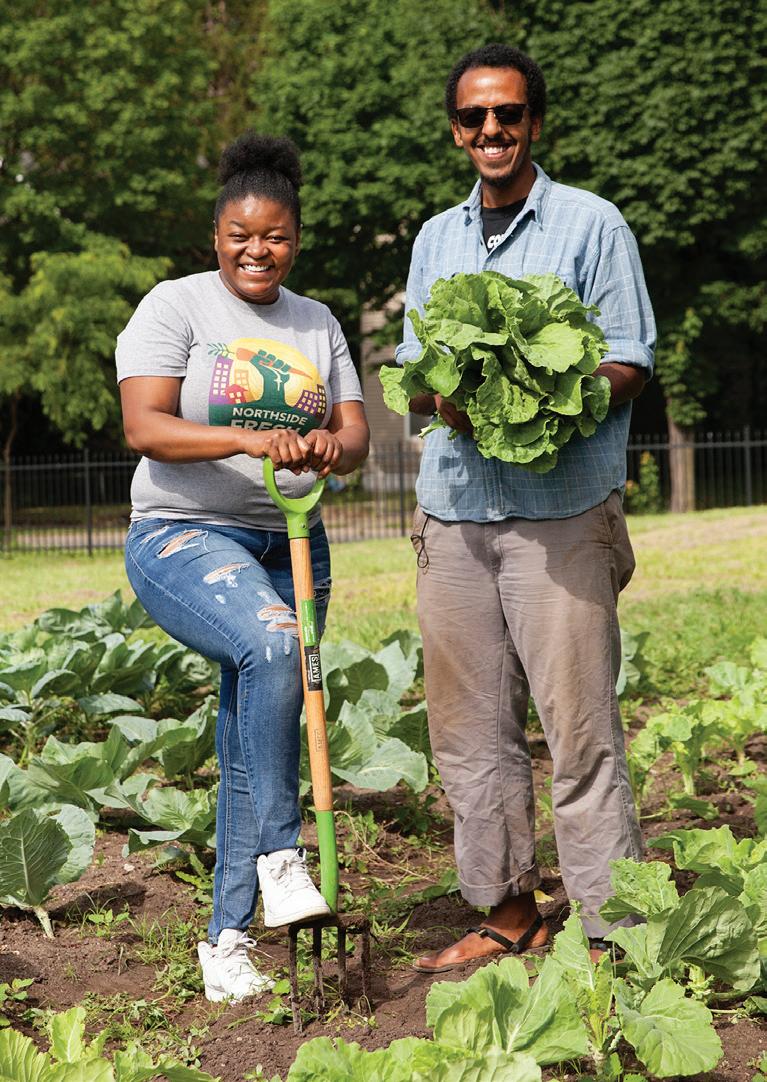
By Kiara Williams Staff Writer
lack women have long been at the heart of agriculture, from ancestral sharecropping to modern-day urban farming movements. Princess Titus, co-founder of Appetite for Change, a local nonprofit that uses food as a tool to promote health, wealth, and social change, is a leader dedicated to reclaiming land, food and power for her community.
A grandmother’s hands Titus’ journey into urban farming was deeply influenced by her grandmothers, Odessa and Laura, who used food as medicine and a means of community-building. Odessa pursued a culinary arts degree at 54, while Laura grew her own food to counter health issues. Their example dismantled Titus’s early associations of fieldwork with slavery and oppression, instead fostering a sense of pride in harvesting food for her family and community.
“The impact of these invitations created a
munity have somewhere to lay their heads.”
That’s what JP staff call a “full-circle moment.”
“We know the systemic barriers that single moms face, such as rising grocery prices, unaffordable rent, and the skyrocketing cost of child care. With current economic conditions, every single day they are being asked to do more with less,” said Chastity Lord, president-CEO of Jeremiah.
The program has its roots in Minneapolis-St. Paul but locations in seven states.
“Our work is about changing that narrative, creating spaces where single moms feel seen,
■ See JEREMIAH on page 5

By Aria Binns-Zager Staff Writer
he latest Sister Spokesman event was a testament to the resilience, creativity and determination of Black women in the media. Attendees were treated to an insightful and unfiltered conversation featuring a dynamic panel of Black women journalists, each sharing their experiences navigating an industry historically dominated by white men.
The panel featured Jasmine McBride, the new associate editor at the Minnesota Spokesman-Recorder (MSR); Georgia Fort, an Emmy Award-winning journalist and founder of BLCK Press; and Kiara Williams, an MSR staff writer and cultural curator. The discussion was as
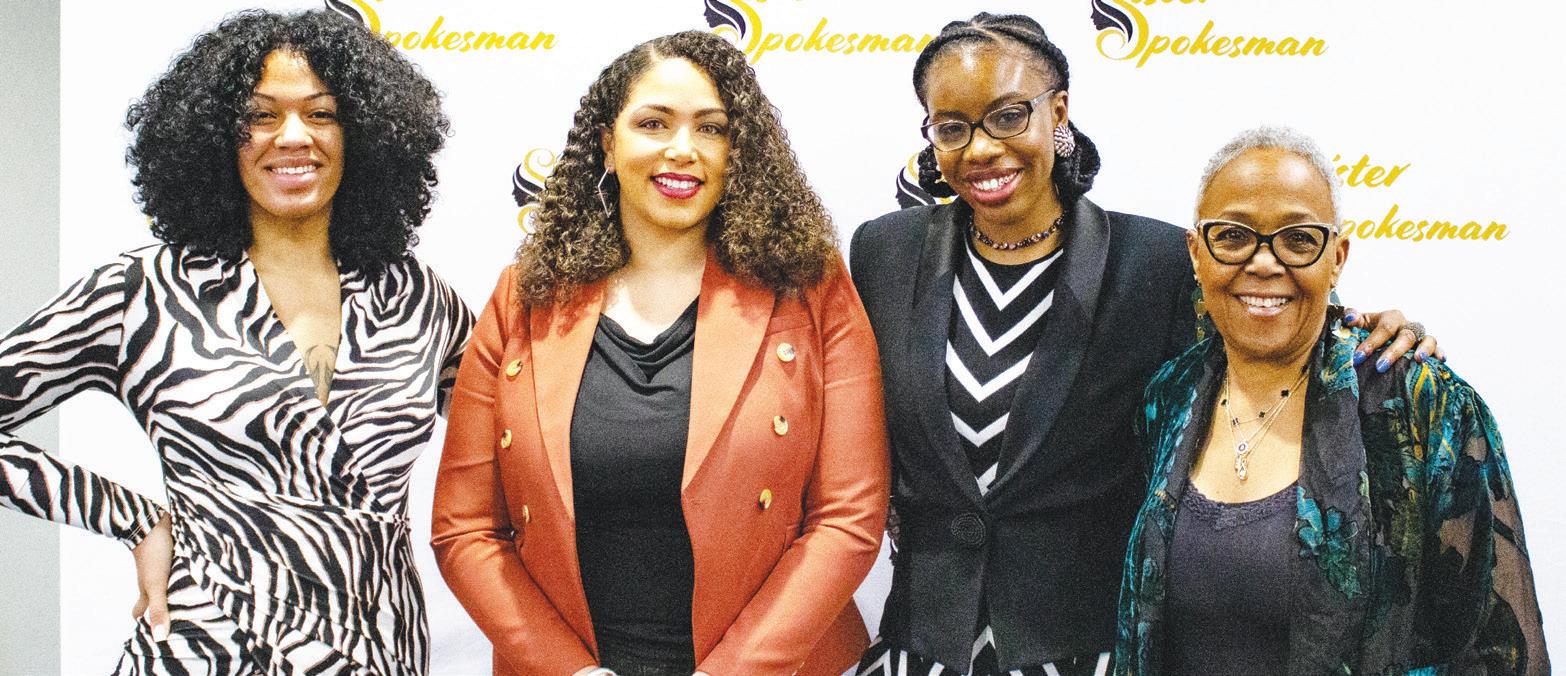
By Clint Combs Contributor
orma Izaguirre asked her lawyers in Spanish if she could add comments about her time at Absolute Drywall. Minutes later, she was crying in the green room outside the press conference room at the State Capitol last Tuesday, March 4. Through a Spanish-English translator, she shared with reporters that she believed the contractor fired her for at-
tempting to report Juan Diego Medina Cisneros for sexual assault while she was cleaning a bathtub at the Viking Lakes apartment complex in Eagan. The company initially claimed the relationship was consensual, but Medina Cisneros has since pleaded guilty to sexual assault and will serve three years in prison. Now, three years later, the state’s Department of Human Rights and the Minnesota Attorney General’s Office have joined Izaguirre’s lawsuit,

which alleges the subcontractor repeatedly ignored claims of harassment and then fired her. “I am grateful again for the state’s decision to join my case,” Izaguirre said, “and this is an acknowledgement of not only my truth, but also the unacceptable reality that women like me, Latina women, too often face sexual harassment and assault in the construction industry.”
Rebecca Lucero, commissioner of the Minnesota Department of Human Rights, emphasized the department’s commitment to investigating all discrimination complaints. “Under the Minnesota Human Rights Act, we investigate all complaints of discrimination, period. We do not ask or look into anyone’s immigration status.
“We are focused on discrimination itself. Discrimination should not happen in Minnesota, period,” she said.
In a related study, the National Library of Medicine
surveyed 52 Hispanic women from various low-income jobs

in Boston about sexual harassment and misconduct in the workplace. The study found that 41 women had either experienced or witnessed sexual harassment at work.
Notably, 34% of these workers were employed at companies with fewer than 10 employees. The study also highlighted several common barriers to reporting sexual harassment and retaliation faced by workers.
“If you file a charge of discrimination with our department, this is a public setting,”
said Lucero. “A vast majority of situations are not public.
However, investigations are conducted in a neutral, factfinding manner. All of the information is kept confidential, and these investigations are done thoroughly.
“Most everything is settled if we find probable cause of discrimination. Our job is to prevent discrimination from happening from the front end and to put systems in place to keep it from happening in the future.”
Barriers to reporting included fear of being fired (34%),
lack of awareness of the reporting process (24%), threats from the harasser (17%), and feelings of shame or guilt (15%). Additionally, victims experienced retaliation, including reduced work hours (12%), termination (12%), resignation due to lack of support (10%), and threats related to their immigration status (10%).
Minnesota Attorney General Keith Ellison lauded the MDHR as one of the “strongest civil rights laws in the country. “What happened to Norma was appalling,” Ellison said. “Absolute Drywall’s response to what happened was appalling as well, and by joining this lawsuit, we want to send the strongest possible message to everyone in construction and in any other sector that you must care for the rights, protection, and dignity of all of your workers.”
Black workers accounted for 71% of the 1,945 sexual harassment charges filed si-

Frequently throughout 2025, space in these pages will be given to organizations working to end racial injustice across the state. We hope that these reflections spark policy changes for a more equitable Minnesota. This week’s guest contributor is Beth Holger, a resident of the Camden Neighborhood and CEO of The Link.
By Beth Holger
Youth experiencing homelessness often go unnoticed in our community. These young people face immense hardship, struggle and trauma. At the same time, they are among the most insightful, strong, resilient and inspiring individuals I have ever met. I have the honor of working with youth experiencing homelessness and survivors of sex trafficking in North Minneapolis through The Link.
The Link is a youth- and adult-led nonprofit founded in 1991 by former Minnesota Vikings players Jim Marshall and Oscar Reed. The organization provides a variety of services, including emergency shelter and housing programs, for youth and young families experiencing homelessness, survivors of sex trafficking, and those involved in the juvenile justice system — or, as we call it, the “non-justice” system.
Racial disparities are evident among youth experiencing homelessness, those victimized by sex trafficking, and those involved in the juvenile justice system in our community, state, and across the country. In Minnesota on any given night, 4,872 youth experience homelessness. Of these, 70% are Black, Indigenous, Hispanic, or multiracial, compared to just 26% of the general youth population. Additionally, 20-40% of youth experiencing homelessness identify as LGBTQ+, compared to 3-5% of the general youth population. These disparities are a direct result of historical and present-day systemic racism.
“To truly reduce and ultimately end youth homelessness, we must address racism, reform our systems, and center youth leadership in the process.”
To truly reduce and ultimately end youth homelessness, we must address racism, reform our systems, and

center youth leadership in the process. Fortunately, Minnesota has a plan to do just that through the state’s Homeless Youth Act. This legislation is a grassroots, community-based effort initiated by youth and youth workers — most of whom are people of color — to combat youth homelessness.
The Homeless Youth Act was first introduced in 1999 by a dedicated group of youth with lived experience and youth workers. Since then, we have worked tirelessly to secure its passage and expansion, with the ultimate goal of reducing youth homelessness to functional zero in Minnesota. The act provides inclusive definitions of “homeless youth”
and “family,” establishes a continuum of services, and allocates funding for shelter and housing programs.
In the early years, changing the public and legislative narrative about youth experiencing homelessness was a challenge. Many policymakers initially believed these were “bad kids” running away from home rather than young people fleeing poverty, homelessness, exploitation, racism, oppression, abuse, or rejection due to their sexual orientation or gender identity.
It took persistent advocacy and education to shift this perception. Youth and youth workers repeatedly showed up at the State Capitol, learn-
Vybez: Come, feel welcome, do unconventional things
Aria Binns-Zager Staff Writer
On the East Side of St. Paul, a new cultural hub is bustling into the scene and it’s a “Vybe!” More than just a space, Vybez is a movement, a dream realized by Martrelle “Trey” Brown.
“Vybez is [referring to a vibe] just that,” Brown explains. “It’s a community space. It’s a dance studio. It’s an art gallery. It is a place where people of color can come and just kind of find that creativity that they’ve been looking for.” Vybez was born out of Brown’s eclectic interests. “I get bored a lot. So, I’ve been doing a lot of creative things throughout the years, like building large games. I do burlesque. I do all sorts of things,
and I kind of needed a place where it all could coalesce into one,” he shares. That vision took shape when he stumbled upon a vacant space on Facebook Marketplace. “I saw it, and something was like, go look at it. And when we got in here, nothing was here. And I said, ‘Oh, I got a vision.’ And two months later, here you go. I have been working on this for two months by myself.”
Despite its rapid development, Brown has even bigger dreams for Vybez. “The goal is to make one here, one in Minneapolis, one in Brooklyn Park. I want it to be a space where it’s kind of like a brand. Where are you going tonight?
I’m going to Vybez. Like, what could that be? It could be anything.”
For Brown, the East Side holds deep significance.
“Most of my family moved up here from Gary, Indiana. Half of us moved to Minneapolis, and the other half moved to the east side of St. Paul. So I’ve lived in both places.
“Although I live in Minneapolis on the North Side now, I’ve always kind of missed that St. Paul connection. My family members are right off the street. So I needed a place where I could just be like, hey cousin, come see your cousin. And so the East Side is a perfect space for me.”
But Vybez is not stopping in Saint Paul. Brown’s vision of another location in Minneapolis extends to a particular community. “Specifically, North Minneapolis, because I think it needs it. One, I live
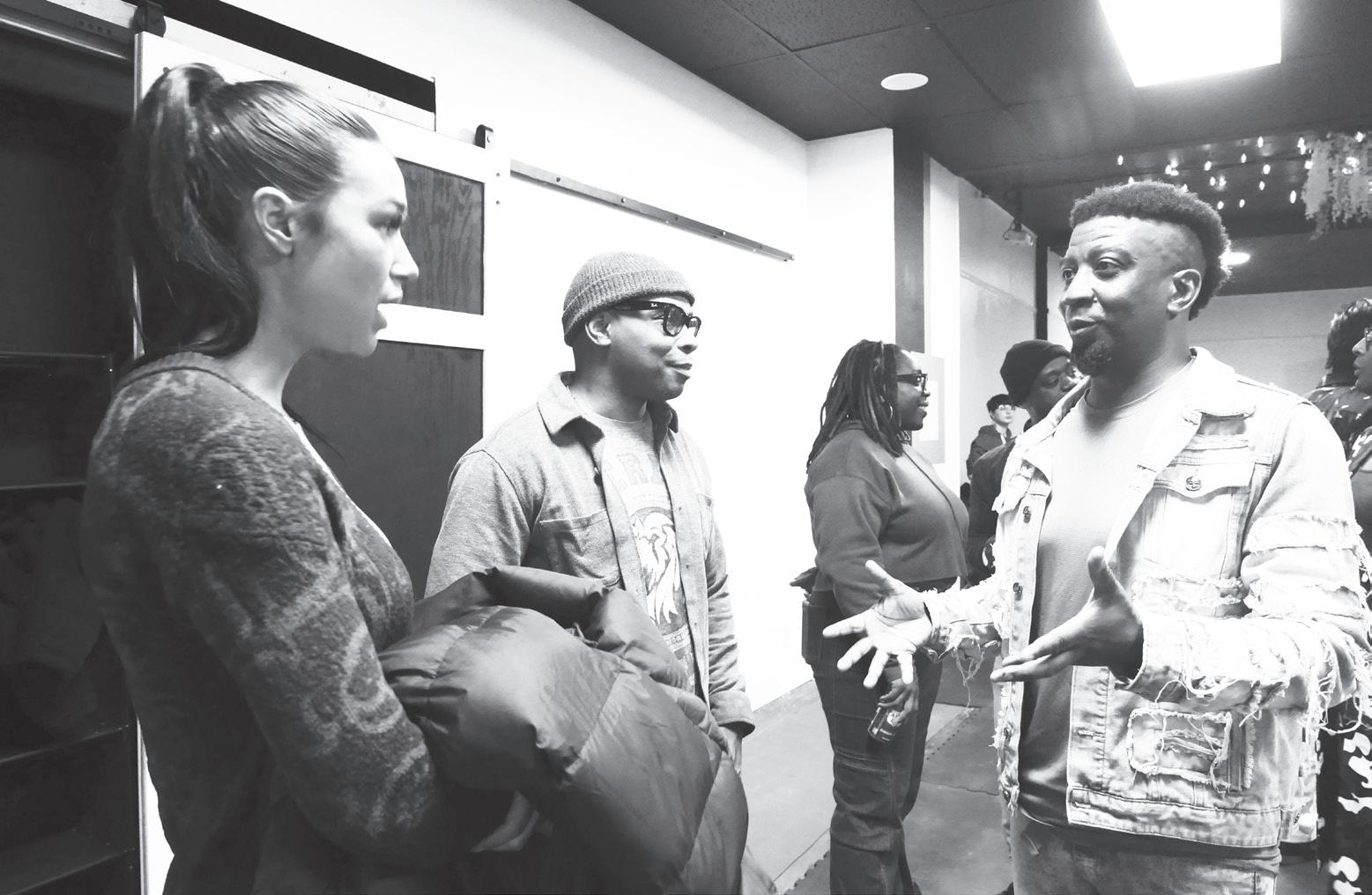
there and don’t see anything else like this,” he says. “I just want a space where people, again, can come and feel welcome. And do unconventional things.”
Events at Vybez are already taking shape. “I think we’re going to do a throwback movie night. Come bring your blankets and we’re going to put the movies on the projectors. We have three projectors so you can get a full immersive situation. And just tell people, let’s go eat popcorn and watch, I don’t know, The Goonies or School Daze or something like that.”
Brown’s vision is simple but powerful: “I want it to be a spot where you genuinely say, ‘I’m gonna go there because I don’t know what’s gonna happen.’ I want people to bring other people in and say ‘Where are we going tonight? Vybez. What are we doing? I don’t know. But it’s gonna be amazing. It’s gonna be a vibe.’
“And I want them to leave and come back and say it was a whole different place. ‘I went there last week for this and this week for this.’ And as long as that keeps going and evolving, I’m happy.”
Vybez wouldn’t be possible without the team behind it, including Bianca Rhodes, the event coordinator and cobusiness owner. “It’s crazy because there’s so many different vibes within Vybez,” says Rhodes. “Right now, we’re on the main floor, ‘Grandma’s
ing the legislative process and demanding change.
Since 1999 we have returned year after year to advocate for increased funding.
Over time, we built a coalition of youth-serving nonprofits, the Youth Services Network (YSN), to amplify our efforts.
In 2023 we achieved a breakthrough: Funding for the Homeless Youth Act was tripled to $41.5 million over two years. While this is a significant step, we estimate that $500 million per year is needed to fully address youth homelessness statewide.
Over the past two decades, this funding has allowed us to expand emergency shelters, housing programs, and servic-
es. As a result, Minnesota has seen a 17% reduction in youth homelessness since 2018. The evidence is clear — investing in youth experiencing homelessness works. We see it firsthand in the lives of the young people we serve, and the data supports it. Our work is far from over. We will continue expanding resources with youth leadership and input until every young person in Minnesota has a safe and stable place to call home.
If you are interested in joining the movement to reduce and end youth homelessness, reach out to The Link at www.thelinkmn.org.
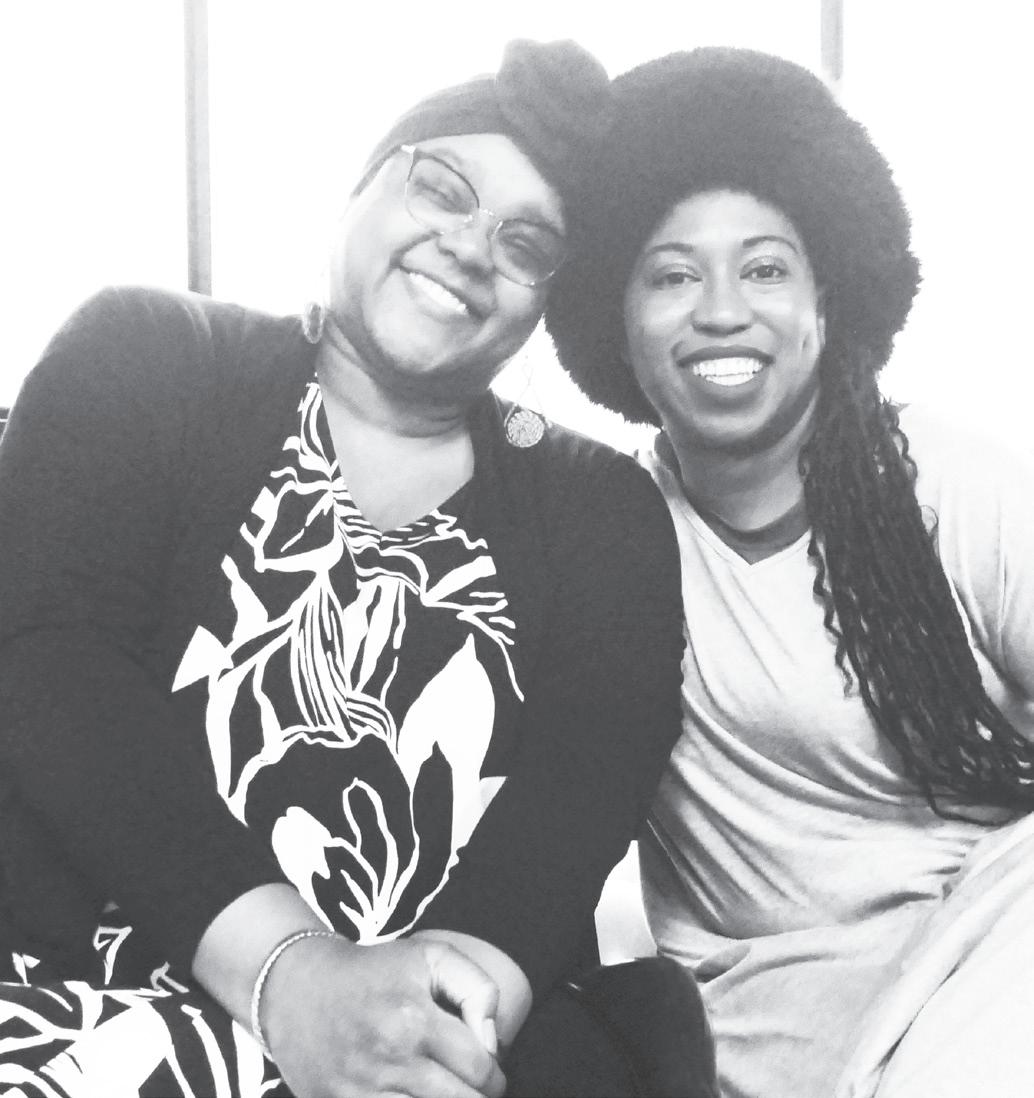
house,’ and it’s like an art installation of everything that you probably grew up in. If you were an 80s baby, that living room was probably what you grew up in.
“The
“And then we have a karaoke room. We have a back room where you can play games. We have three projectors, and so they can turn on simultaneously and have visuals, video games, we’re gonna have screenings, we’re gonna have movie nights, it’s just gonna be a blast. So I’m really excited.
“Having sound baths, healing arts, yoga, burlesque classes,” Rhodes continues. “Martrelle is a burlesque instructor. So you’ll learn body positivity and you’ll learn how to move your body in a new way. So that’s what I see for the future. It’s gonna be absolutely amazing.”
From an empty space to a growing cultural hub, Vybez is a testament to community, creativity and perseverance. And as Rhodes puts it, “The future of Vybez will be like a Black-ity Black, Black on space with Black-ity Black things happening, smelling like shea butter and incense every day. People are gonna enjoy themselves. And find their vibe.”
Follow the journey at @vibes. world.
Binns-Zager welcomes reader responses at abinns@ spokesman-recorder.com.

Sponsored by
Aria Binns-Zager Staff Writer
In Minnesota, significant racial disparities exist in drugrelated arrests and substance use disorder outcomes. Black individuals are disproportionately affected, being 5.4 times more likely to be arrested for marijuana possession compared to their white counterparts despite similar usage rates.
Additionally, the African American population, which represents 7% of Minnesota’s total population, accounts for 13% of all drug overdose deaths.
Organizations like the Twin
Cities Recovery Project (TCRP) are working to change this narrative by offering resources tailored to the needs of these communities. Karissa Mariee, COO of the TCRP, highlighted their commitment to removing financial barriers that often prevent people of color from entering the field of recovery work.
“We offer a peer recovery specialist training for all individuals,” said Mariee. “However, it is of no charge to Black and brown individuals. That allows them to get certified through the Minnesota Certification Board. And then they can become certified peer recovery specialists.”
TCRP embraces means of keeping individuals safe while they navigate their journey with substance use. Mariee explained, “We believe in harm reduction. We do outreach. And we also have supplies where people can stop in and pick up.
“We’re not a syringe ex-

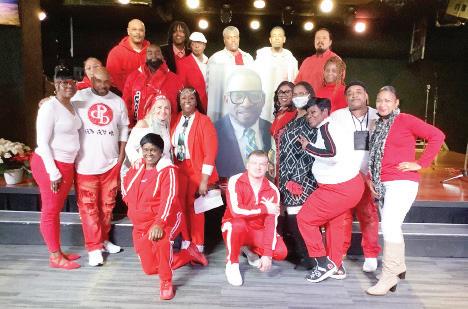
change, but we do also clean syringes and different supplies because we believe in keeping people safe. And at some point, if [people] decide that they’re ready for recovery, they’re going to come back to us for that help because they’re going to feel that bond with us.”
The organization’s work extends into encampments, offering vital resources to individuals experiencing homelessness and addiction. Mariee noted, “So primarily our focus is Black and brown. Most of our staff are brown, of color, Black, and most, 99% of our staff, are also people in longterm recovery. So we literally have walked in the shoes of people who need long-term services.
“We go into the encampments and offer resources. People can stop in and get resources. It’s anybody who suffers from addiction.”
Despite their essential work, organizations like TCRP

Obituary
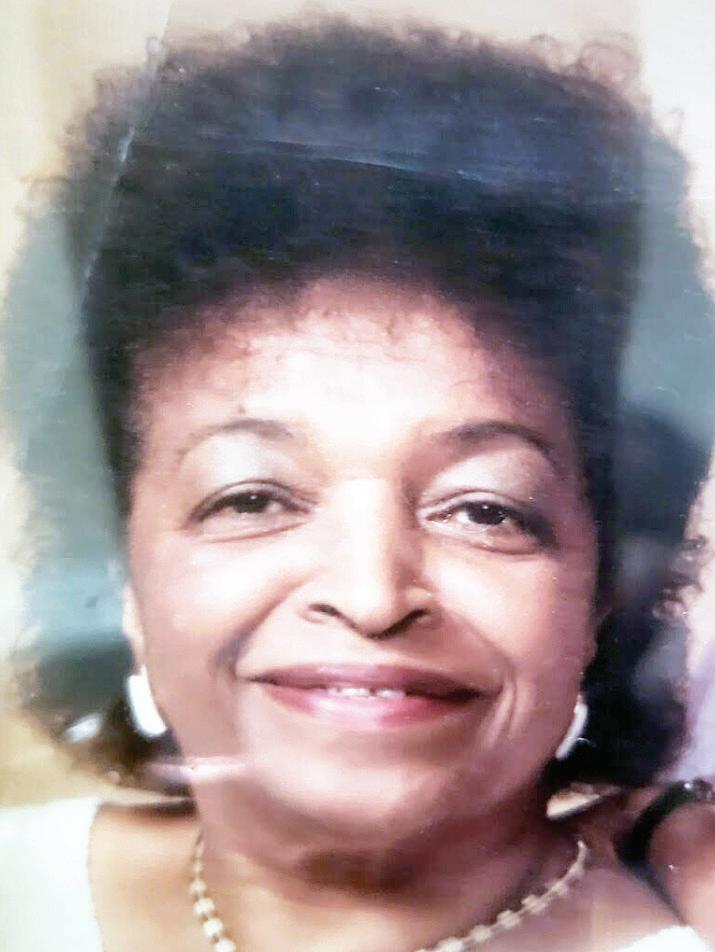
Patricia Jane Ingram passed away 11/18/2024 at her home at the age of 101. She was a resident of Minneapolis. Born on March 13, 1923, in Minneap -

olis, MN, she was the loving daughter of mother Eva Smith Mallory and father Robert Mallory. She was preceded in death by her parents, her son Grover (Rocco) Ingram Jr., daughter Nancy Lynette Ingram, sister Barbara Mallory Cyrus, brother Robert (and sister-in-law Barbara) Mallory Jr., as well as friends Royd Jackman and Theodosia Martin.
Pat is survived by her loving grandson Daniel L. Thomas, niece Denise Mallory Ellis, her son Robert Ellis, family Kristi Lee and Marc (Debbie) Ingram, and friends Deacon Diane McGowan and Juanita Moss; along with a host of neighbors and friends. She was a long time and loved member of St. Thomas Episcopal Church.
Patricia’s memorial service takes place on Saturday March 15, 2025 at 1:00 pm at Gospel Temple (COGIC), 247 Grotto St N, St.Paul MN 55104.
Thanks for all the support for her family and friends.

face uncertainty due to shifts in political and funding landscapes. Mariee expressed concern, saying, “Because the change is every day, I don’t know what to expect. However, it’s scary because our work is heavily grant-funded and the climate of the language and all the things, it is scary because I don’t know what’s in it for us.”
As federal and state funding structures change, organizations serving Black and brown communities are particularly vulnerable. Mariee added, “We also are going to be affected by all the racism because we are a Black organization.”
Kathryn Hogan, a mental health housing and supportive housing case manager, shared her personal journey through addiction and recovery. She recounted, “I was in active addiction through my 20s, 30s, and 40s. Cocaine, alcohol and marijuana.
“But my journey changed

three years ago. I got tired of the lifestyle and everything that came with it — the health problems, the mental health issues, the depression, the anxiety, the paranoia. I just got tired of the whole lifestyle.”
“I was in active addiction through my 20s, 30s, and 40s. Cocaine, alcohol, and marijuana. But my journey changed three years ago.”
Hogan’s road to recovery mirrored the journey of many who have found hope and healing through the programs offered by TCRP, which provided structured support to help her regain stability. Today, she is pursuing a master’s degree in alcohol and drug counseling focusing on mental health at
Obituary
Taft H. Martin

Taft Howard Martin was born December 11, 1950, to Teddie and Evelyn Martin. Taft was the third child of five. Taft grew up on the Northside of Minneapolis. Taft was a charmer. Everyone he met was a friend. In his career,
Metro State University. She explained, “I wanted to become a counselor to help people get off drugs and alcohol. It definitely is a correlation to my experience. I want to bring that to other people so they can have hope to stop using.”
For Hogan, recovery meant rebuilding relationships and finding new purpose. She noted, “My mental health improved. I started to have a clear mind. Everything improved. My whole outlook on life improved. My depression improved and — or went away. I don’t feel depressed anymore. My anxiety is not there. So my mental health definitely improved.”
The work of organizations like TCRP and individuals like Hogan illustrates the urgent need for equitable addiction recovery services in Black and brown communities. Harm reduction strategies, peer support, and lived experiencebased care models are essential to combating the crisis. However, sustainable funding and policy changes must ensure these services remain available.
With racial disparities in addiction treatment persisting, it is imperative that community members, advocates, and policymakers work together to dismantle systemic barriers and create lasting change. The fight for equitable recovery cannot be just about saving lives; it’s about affirming the right of Black and brown individuals to access the support and care they deserve.
Aria Binns-Zager welcomes reader responses at abinns@ spokesman-recorder.com

he had many jobs from construction worker, to work with Honeywell, to Control Data; everything sparked his interest. Taft was a free spirit. He lived his life his way. He was a sharp dresser and a handsome gentleman.
Taft was preceded in death by his father and mother, brother Theodore (Teddy) Martin, sister Denise Frazier, and daughter Cretia Combs. He leaves to mourn his passing, daughters Delicia Jackson, Kandace Cooper Hart, Sharonda Hubbard, Minyone Riddley, and Phillis Dudley Martin; his sons, Maurice Gardner and Daniel Dudley; as well as 14 grandchildren and 33 great grandchildren, sister Barbra Martin, brother Robert Martin, and aunt Beanie. Not to forget, a host of nieces, nephews, great nieces, great nephews, great-great nieces, and great-great nephews, cousins, friends, and his long-time partner Carmen Denise Caston.
His celebration of life will be on Friday, March 21, 2025, at Estes Funeral Home, 2201 Plymouth Avenue N. at 2 pm viewing, 3 pm service. Repast to follow from 4 pm to 9 pm at 5890 Central Ave NE., Minneapolis, MN 55432.



By Kiara Williams Staff Writer
The morning sun casts long shadows over the fields as farmers swiftly load crates of freshly harvested produce onto a waiting distribution truck. The scent of damp earth and ripened vegetables fills the crisp Minnesota air. A rhythmic chorus of voices calls out orders as hands pass boxes from one to another, each filled with vibrant greens and fragrant herbs. The truck’s reverse alarm beeps steadily, a signal of movement and progress.
Standing at a distance, Marcus Carpenter watches with quiet satisfaction. His dream, Route1 — born from a time of crisis and a deep-rooted passion for agriculture — has manifested before his eyes. The food will soon be on its way to those who need it most, carrying a message of resilience and empowerment.
“When you hear the beep as the liftgate of a truck goes up, and you see those thousands of pounds of food going in that truck, we know that that food will eventually land in the bellies of those who really need it the most,” Carpenter said, referring to Route1’s frequent food distribution efforts, where harvests are allocated to food shelves, shelters and nonprofits. “For us, that’s been the most rewarding part, knowing that people are being fed by the food we are growing.”
Route1, a social enterprise fiscally sponsored by the Social Good Fund, has been making waves in Minnesota’s agricultural landscape since its founding in 2020. Headquartered in Hamel, Minnesota, Route1 operates two farms: one in Medina spanning 13 acres and another in Loretto covering 16 acres. Their hydroponic Freight Farm at the Medina site yields an impressive 200 pounds of fresh produce per week, year-round — equivalent to the output of 2.5 acres of traditional farmland.
The inspiration for Route1 stemmed from the social justice movement following the
murder of George Floyd. Carpenter, a former corporate leader with deep familial ties to agriculture, saw firsthand how food scarcity disproportionately impacted marginalized communities during the height of Covid-19.
“After the murder of George Floyd, I saw the supermarkets that were closed down on the North Side at that time. I saw how food was being delivered to our communities, and I knew that I couldn’t sit on the sidelines. I had to do something. So, Route1 is the fruit of all of that thought that was happening that summer,” he said.
Having split time between Minneapolis and the 140-acre Carpenter Family Farm in Arkansas during the pandemic, he witnessed how large food retailers were leaving Black and brown communities. This, combined with the lack of economic development for business owners of color, led him to create Route1. The platform supports emerging farmers of color by increasing food access, promoting health equity, creating career opportunities, and providing individuals with the tools to build generational wealth within their communities.
Carpenter spoke about his agricultural roots: “My greatgrandparents launched that farm in 1914, and at one point it was the largest Black-owned farm in northeast Arkansas.
Growing up in a farm family, I always knew that connecting with the soil, connecting with the earth, and getting your hands in the dirt was grounding. This helps individuals not only connect with the land and growing food, but it also helps them connect with themselves.”
To date, Route1 has supported over 90 emerging farmers from diverse backgrounds, including Black, Native, Latino, African, Asian, and various immigrant communities. Beyond agriculture, the organization creates job opportunities for youth and community members, reinforcing the idea that they belong in the agricultural

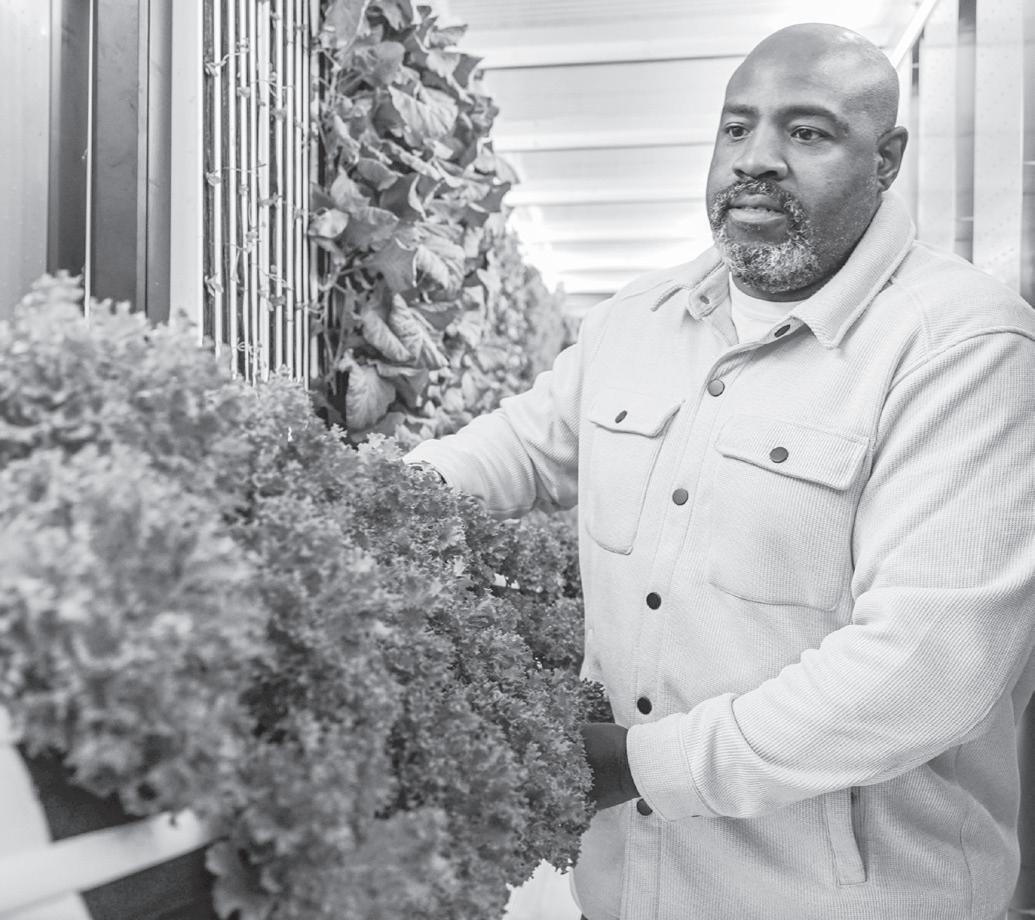
space. Over the past four years, Route1 has distributed 70,000 pounds of fresh food to the community, with no plans to slow down.
For Carpenter, the biggest challenge has been prioritizing time to ensure the organization effectively executes its mission. However, the most rewarding aspect remains clear: “Knowing that people are being fed by the food we are growing.”
Education is woven into all aspects of Route1’s programming, ensuring that emerging farmers and community members alike develop the knowledge and skills necessary to thrive in agriculture. The organization operates three core programs:
• Emerging Farmers Institute — Helps farmers grow their businesses through training and mentorship.
• Seeds to Success Youth Academy — Introduces young people to the agricultural sector, planting seeds of interest.
• Market Development — Assists farmers in becoming profitable through six distribution channels: community development, employee-supported agriculture programs, corporate dining partnerships, farmers markets, chef collaborations, and direct-to-consumer subscriptions.
Carpenter said these core components increase food access for communities in need, offer greater support for emerging farmers, and help preserve sustainable agricultural practices for future generations. Climate resiliency and stewardship are also at the heart of this mission.
Looking ahead, Route1 recently launched a direct-toconsumer subscription service, allowing more individuals to support and enjoy local produce. Additionally, the upcoming Route1 Urban Agriculture & Conservation Micro Campus (UACC) aims to bring community gardening, controlled-environment agriculture, educational initiatives, and climate conservation efforts to the community. The project focuses on revitalizing fallow land to support biodiversity and ecosystem health.
“At the end of the day, you can’t grow good food if you don’t have good soil. This


educational institutions, corporate sponsors, philanthropic groups, and government agencies at the city, state and federal levels. These collaborations fuel the enterprise’s ability to expand and sustain its mission.
Beyond the organization’s progress, Carpenter said he is most grateful for the individuals and organizations that continue to support Route1 with their time, talent or treasure.
This includes volunteering, spreading awareness, joining the team, purchasing produce from Route1’s emerging farmers, or making a donation. Carpenter closed our dis-
cussion with his vision for the future: “Really, what we’re trying to do is recreate the themes of the Black church, the Black barbershop, the Black beauty shop. Think about places that were in our communities at one point that served as a meeting ground to discuss the topics of the day. We want to recreate all of that, but do it around agriculture, good food, and good community.”
For more information, visit www.route1mn.org.
Kiara Williams welcomes reader responses at kwilliams@ spokesman-recorder.com.
whole demo cover crop area is really about ‘How are we stewarding the earth? What types of plants can we grow that will allow for more nitrogen, more phosphorus in the soil, and an overall better environment for our world?’” Carpenter said.
“You can’t grow good food if you don’t have good soil.”
Route1 has built strong partnerships with 27 community organizations, including


Continued from page 1
heard and supported,” said Lord.
Services beyond safe and affordable housing support that JP also offers include college access and career support, empowerment and leadership training, networking and community-building support.
JP also offers on-site child development centers in five of its nine locations, as well as connections to local early childhood education programs at its four off-campus locations.
Lord said the program’s mission is one that is deeply connected to “collective dreaming” — the idea that no single mother should have to navigate poverty, child care challenges, or career barriers alone.
The organization just completed its 2025 Summit Weekend March 7-9 at Mystic Lake Center in Prior Lake, as well as its expanded virtual SummitX, continuing its mission to sup-
Continued from page 1
craving in me to grow food and keep that culture of liberation and power — being in solidarity with the land,” Titus said, reminiscing how her grandmothers grew her interest in growing food, as if she were part of the harvest herself.
Food sovereignty in food deserts
Women, particularly Black women, have been at the forefront of food justice, ensuring equitable access to fresh, nutritious food in underserved communities. For example, civil rights activist Fannie Lou Hamer founded the Freedom Farm Cooperative in 1969 in Mississippi. This initiative sought to combat economic insecurity and food scarcity
port single mothers and their children, proving that success is not just about surviving — it’s about thriving. And its alums are walking proof that the program works.
“When I first joined Jeremiah Program, I was in dire need of a support system that my own family was unable to provide,” Nekey Oliver shared.
“The women I had the privilege of meeting have become like a second family to me. In fact, I am now the godmother to one of their children.”
degree in sociology, Oliver pursued a career in government relations and community engagement, determined to advocate for families like hers. Today, she serves as director of government relations and community engagement for the Minnesota Office of Higher Education.
“I am one of the youngest directors at a state agency, and I attribute a significant portion of my success to the opportunities and experiences JP afforded me,” she said. Her full circle moment includes
“I was able to secure a stable job with a regular salary, benefits, and child care assistance. That stability made all the difference.”
JP became more than just a second family and safety net; it was a launching pad for Oliver’s career and leadership journey. While at JP, she was introduced to influential mentors, including the founder of Evereve, who became a lifelong friend and inspiration.
After graduating from the University of Minnesota with a
among Black communities by promoting land ownership and sustainable farming practices.
Today we have many women-led organizations doing the same work, nationally and here in the Twin Cities. In addition to Appetite for Change, The Lakeview Terrace farmers market, founded by Chaz Sandifer, makes history as the only Black-women-owned farmers market in Minnesota. The belief that urban farming is a direct response to systemic food insecurity is evident amongst Black women in agriculture.
“Urban farming is our resilience in action, a way to respond to the food system that we complain about — one that makes us sick and closes the doors of stores in our neighborhoods,” Titus said.
West Broadway in North Minneapolis, like many predominantly Black communities, faces a landscape dominated by fast-
serving on Jeremiah Program’s Minneapolis-St. Paul Community Board of Trustees.
“Serving on the JP board allows me to contribute my voice and share my experiences as a mom and alum, inspiring and supporting other moms in the program,” she said. “I’m proud to advocate for those who are often mis-
food chains while lacking grocery stores that cater to residents’ nutritional needs. With recent closures of stores like Aldi, Dollar Tree, and Walgreens, the urgency to create sustainable food systems has only grown.
Appetite for Change has spent 14 years engaging the Twin Cities community in growing and cooking food while fostering conversations about social change. “One of the questions that came up is what do we do if the food trucks don’t come into our community?” Titus said, emphasizing the necessity of self-sufficiency.
“I have to acknowledge the hardships we face are what pushes us to be our own solution. Believe that you can do it, and start small. If you have a raised bed, you can grow strawberries, tomatoes, salad greens and cucumbers. That gives you access to a fruit that comes back every year, plus
understood, but undoubtedly deserving of support.”
Others have been on similar journeys, including Stasia Saunders who, when she was in her early 20s, faced a choice that many single mothers encounter.
“I found myself a single mom, trying to go back to school, and no matter how hard I tried, I just couldn’t make ends meet,” Saunders recalled. “I had to choose between getting my education to make a better life for us or dropping out and working nonstop just to survive.”
Her heart sank as she prepared to tell her academic advisor she would have to drop out. But that conversation changed everything.
“Thank God I had the advisor that I did,” she said. “He told me about one last possible solution — the Jeremiah Program. I had never heard of it before, but I thought, why not? Maybe this is the answer I’ve been looking for.”
That single moment, choosing to take a chance on something unknown, became the turning point of her life. After
fresh ingredients for salads and cooking greens for Sunday dinner. It’s a great way to supplement your shopping and begin your growing journey.”
Making something out of nothing
Black women in urban farming are employing innovative techniques to maximize food production in limited spaces. Community gardens, vertical farming, hydroponics, and permaculture practices are among the strategies increasing access to fresh produce. These efforts not only provide nourishment but also restore agency over food sources, helping Black communities reclaim autonomy over their food systems and economic futures.
In the early 20th century, agriculture was the bread and butter of the southern Black population. The promise of “40 acres and a mule” was a vastly unful-
graduating from JP, Saunders’ life didn’t become perfect overnight, but she was better equipped to face challenges.
“Life still had challenges, but JP gave me the skills to push through and approach them differently,” she said. “Because of the program, I was able to secure a stable job with a regular salary, benefits, and child care assistance. That stability made all the difference.”
But, she said, the most valuable part of the experience was the network of women she built along the way. “The friendships I made at JP have lasted 20 years. We still check in, celebrate each other’s wins, and support each other. Our kids play together. That community is everything,” she said.
Today, Saunders works as a team lead for a client services team in a financial institution — something she never expected but deeply values.
“I never imagined working in finance, but it has been invaluable,” she said. “Growing up, we lived dollar to dollar. Saving money wasn’t something I
filled promise. Despite this, by 1910, Black Americans owned approximately 15 million acres of land, primarily in the South.
However, due to systemic discrimination and other factors, this number declined sharply over the 20th century, dropping to about 2 million acres by 1997. Today, Blackowned farms currently account for less than 1% of the nation’s farmland, with the number of women-owned farms at approximately 30,000 per the USDA.
Though there are still barriers to land ownership, real change starts with individual action. Growing and cooking your own food can have a ripple effect, influencing those around you while contributing to systemic transformation.
Researching and connecting with others in the movement is essential. One-on-one conversations can reveal opportu-
thought was actually possible. But now, I see how important financial education is, and I want to pass that knowledge on to others.”
For women like Portia Jackson, Nekey Oliver and Stasia Saunders, the Jeremiah Program provided more than just resources; it offered a foundation for transformation.
“At Jeremiah Program, we believe that community is a verb — active, intentional, and sometimes messy, but always worth it,” said Lord. “The moms we serve aren’t just surviving day-to-day; they are reimagining and building a world where they and their children can thrive. And we stand with them in that vision.”
For more information about the Jeremiah Program, visit www.jeremiahprogram.org.
Sheree R. Curry is the director of communications at the University of St. Thomas. She also is the 2025 Women in Business Honoree by the Minneapolis/St. Paul Business Journal.
nities to collaborate, build on existing efforts, and learn from experienced growers. Further elaborating on the importance of self sufficiency, Titus highlights the value in owning the land you grow on.
“Farming takes time, and securing land is a crucial investment in long-term sustainability. Ownership fosters stability, ensuring that the work being done today can continue for generations to come.”
Urban farming, spearheaded by leaders like Titus, is about more than just growing food — it is a movement for justice, health and empowerment. As Black women continue to cultivate change, they honor their ancestral roots while sowing the seeds for a more equitable future.
Kiara Williams welcomes reader responses at kwilliams@ spokesman-recorder.com.
celebratory as it was urgent, shining a light on the barriers that persist and the victories that fuel progress.
Moderator Tracey WilliamsDillard, CEO and publisher of the MSR, set the stage by acknowledging the struggles faced by women — especially Black women — in the media.
“We struggle as women in media when we are up against the male-dominated industry.
Now it has changed over the years, but when my grandmother, Launa Newman, alongside my grandfather, Cecil Newman, started the Minnesota Spokesman and St. Paul Recorder 90 years ago, female voices were silenced, and Black voices were silenced. The world needed to be woken.”
For Fort, the need to create her own media company stemmed from the glaring lack of authentic Black represen-
Continued from page 1
multaneously with a race discrimination charge according to data from the U.S. Equal Employment Opportunity Commission’s (EEOC) study from 2018 to 2021.
Additionally, 37% of the 797 sexual harassment charges filed with a national origin charge identified Hispanic workers, with 15% specifically
tation in mainstream news. “I own a media company called BLCK Press,” she said. “We’re a three-time regional Emmy Award-winning digital news company, and we’ve been around for about five years. “My journey actually started at KMOJ about 15 or 20 years ago,” Fort continued. “The reason why I started my company was in response to the news coverage I was seeing after George Floyd. To turn on the television, to pick up the paper, and not see our community reflected in an authentic way — it broke my heart.”
“To
Fort highlighted the shifting landscape of journalism, where Black creators are carving out their own spaces rather than waiting for inclusion. “We don’t need these networks to tell our stories. In fact, we can
designating Mexican national origin. The data also reveals a troubling trend of retaliation: 43% of the 27,291 sexual harassment charges filed were accompanied by retaliation claims, indicating that many victims face further mistreatment when they report harassment in the workplace. Eagle Building Company is one of many contractors that work with Absolute Drywall. Nick Williams, vice president of the 6th-largest multifamily contractor in the Twin Cities, replied
tell our stories a lot more authentically by going straight to the people via social media.”
As a young editor, McBride sees her role as one of both preservation and innovation.
“I’m trying to honor the roots of the legacy that MSR has been founded on while also bringing in some innovation,” she explained.
“It’s a tricky balance, especially when you only have the capacity for so much. It’s about editorial judgment — understanding which stories will create the greatest impact.”
McBride also touched on the systemic issues that shape how Black communities are represented in the media. “We see a lot of news that negatively impacts the Black community, and there’s an emphasis on that. It’s systemic. So for
via email: “We want to be clear that Eagle Building Company does not support or condone any of the allegations against Absolute Drywall or its former employees. We respect the legal process and trust that the authorities will handle the matter appropriately. Once the situation is resolved, we will assess our business relationship with Absolute Drywall accordingly.”
Clint Combs welcomes reader responses to ccombs@spokesman-recorder.com.
us, it’s about having the eye to recognize what’s relevant today and how to tell those stories in the best way.”
For Williams the challenge isn’t just access — it’s about ensuring that stories align with the mission of Black journalism.
“In my experience, my difficulty isn’t necessarily getting in contact with people — it’s getting them to see eye-toeye with MSR’s mission,” she said. Williams recalled an instance where she was approached for an interview with a prominent tech figure. While her personal passion for technology made her excited, she had to step back and assess whether the story truly served MSR’s audience.
“Yes, you have your accolades, but how does that align with our community? Are you willing to give back? That’s the question. And when I asked that, the response was, ‘I’ll get back to you.’ And they didn’t.”
The panelists agreed that maintaining a strong edito-
rial mission is key. Fort emphasized that media organizations like MSR and BLCK Press have to be selective in the stories they cover. “People send press releases all the time. But just because something is happening doesn’t mean it’s news or relevant to our community,” she noted.
“Why would I write about an art exhibit if my audience is worried about losing their Medicaid or HUD funding?”
The conversation was a powerful reminder of the importance of Black-owned media and the need for more spaces where Black women can lead, tell their own stories, and uplift their communities. With pioneers like Fort, McBride, and Williams at the forefront, the future of Black journalism is in capable hands — unapologetic, mission-driven, and unwavering in its commitment to truth.
Aria Binns-Zager welcomes reader responses at abinns@ spokesman-recorder.com.


By Tamara Pollard
For many, tax season adds another stressor to an already busy life. Add in an uncertain economy and continued concerns about inflation, and the financial angst starts to feel all too real.
But it doesn’t have to be this way. In fact, making the most of your tax refund can set you up for success in reaching your financial goals. And if you already have a sense of what your refund will be, that makes planning ahead all the more doable.
Here are three ways you can put your tax refund to good use this year:
1) Pay off debt — especially credit cards

There’s almost nothing more crippling to your personal finances than a high balance on a high-interest credit card. Carrying over a balance from month to month — even if you’re making the minimum payment — can cost you hundreds if not thousands over time. Paying off credit card debt — or any debt for that matter — is one of the biggest steps you can take to secure your financial future. Putting your tax refund to work tackling your debt will bring you one step closer to accomplishing that goal.
2) Build up your emergency savings Emergency funds can help foot the bill when the unexpected happens, from costly medical or dental bills to urgent care or home repairs. The inevitability of life is that it will throw surprises your way, including in the form of financial shocks. Setting money aside

now means you won’t need to rely on credit cards or personal loans to handle the unexpected expenses that always seem to crop up at the worst time. Whether or not you already have an emergency fund, you will undoubtedly thank yourself later if you put some or all of your tax refund money into such an account.
3) Add to your retirement savings
One of the facts of life is that no one ever gets to retirement wishing they had set aside less money. And the longer you wait to sock more money away in your retirement account, the more you’ll have to pay each month to meet your needs later in life. This concept is called the high cost of waiting, and it’s definitely a price you don’t want to pay. Adding your tax refund to your existing 401K or other retirement savings account is

a surefire way to give a boost to your retirement goals. It’s often tempting to use a cash windfall such as a tax refund to go on a shopping spree, but setting the money aside for a more financially responsible use will leave you feeling better about your financial situation in the long run. Plus, if you’ve fallen behind on those financial resolutions you set at the beginning of the year, now is a great time to revisit what you set out to accomplish. And if you’d like help figuring out what to do with your tax refund, you may want to consider reaching out to a financial profession -





al who can help find the right financial game plan for you, whether that’s paying down debt, securing your savings or investing in your longterm dreams.
Your tax refund is an opportunity to achieve your financial goals — don’t let it go to waste.
Tamara Pollard has 27 years of experience in the financial services industry with Primerica. Through Primerica’s HOW MONEY WORKS™ financial education guide, Tamara teaches clients basic financial principles on how to better prepare for a more secure financial future. https://therealhowmoneyworks. com/us/tpollard.




By Kiara Williams Staff Writer
Minneapolis-based artist
Kovan Baldwin is a name attracting global listeners. With a sound that fuses pop, R&B and soul, Baldwin is on a mission to make music that resonates with diverse audiences while staying true to his values. His journey, filled with perseverance, key industry moments, and an unwavering commitment to clean, meaningful music, sets him apart as an artist with both talent and integrity. He stresses the importance of making music that can translate across the ears and hearts of many cultures. “You never know what people are going through,” he says. “Music has the power to change peoples’ lives, and I want to use my voice to contribute to that [positive] change.”
Baldwin’s love for music started at an early age, inspired by fond memories of watching The Temptations and being captivated by their timeless melodies. His passion was further nurtured by a dedicated choir teacher who recognized his vocal abilities and encouraged him to continue honing his craft. These early influences planted the seeds for his unique sound, while also serving as a foundation of confidence that he would continue to build on for years to come.
A sound like no other
In a crowded industry, Baldwin stands out not just for his vocal ability but also for his
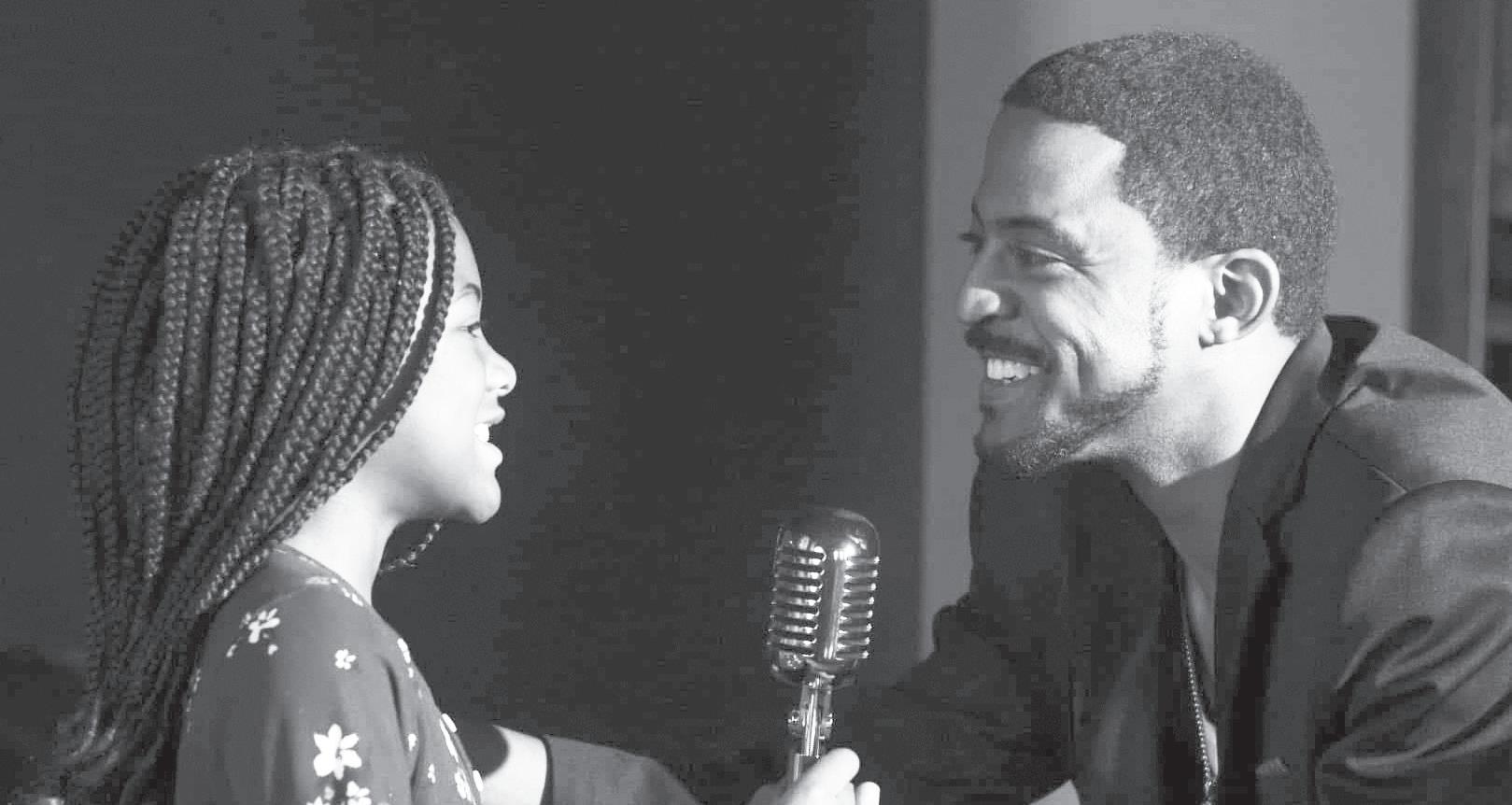
commitment to producing clean, uplifting music — much like his idols, The Temptations. His goal is for listeners of all ages to enjoy and connect with his music.
Thus he makes music that requires no after-production tampering: “My music doesn’t need to be edited to be clean, because it already is.” His distinct sound allows him to appeal to a broad audience, including those who may not typically listen to his genre.
Baldwin describes his creative process as kinetic — hooks come to him unexpectedly, whether he’s working or not, even in his sleep. He often records voice memos to capture melodies, later collaborating with producers to bring his ideas to life. His organic approach to songwriting results in music that feels fresh, authentic, and deeply connected to his personal experiences.
Asked about his long-term legacy, Baldwin wants his name to be synonymous with a man of integrity. “I want my name to come up and have people declare he is who he says he is,” he emphasizes. Fortune and fame is always welcomed, but that is not his singular focus.
opportunity to perform live on Channel 4, WCCO — a breakthrough moment in his career. To date “Call Me” has over 68,000 views on YouTube.
By 2013, Baldwin found himself in negotiations with major labels “Bad Boy” and “Cash Money Records.” While he ultimately did not sign with
“My music doesn’t need to be edited to be clean, because it already is.”
Milestones and major achievements
Baldwin’s journey as an artist has been marked by defining moments that validated his hard work. In 2012, he reached out to news anchor Reg Chapman via Facebook Messenger, sending his song “Call Me.” Chapman not only complimented Baldwin’s work but also provided him with the

industry and reinforced his belief in his own artistry.
Reflecting on this period, Baldwin shared, “It taught me a lot about who I am in life and where I want to go. It gave me direction and purpose.”
In 2021, Baldwin had another standout moment when he performed at the Mall of America, a milestone that symbolized his growing influence. His single “Last Man Standing” further solidified his place in the industry, reaching #25 on the Top 50 Hip-Hop & R&B charts and #84 on the Global Charts on Digital Radio Tracker. Being recognized alongside mainstream artists like Drake and Ed Sheeran was a defining moment, fueling his motivation to keep pushing forward.
Musical message and inspiration
commitment and positivity are at the heart of his work. This is beautifully reflected in his upcoming singles, “Dream Girl” and “Say Yes,” both of which explore the profound significance of deepening commitment in a relationship.
A lot of artists are fueled by the hopes of achieving fame and fortune; this is not the case for Baldwin. Instead, he prefers to make a difference in his listener’s life with relatable melodies. His message is impact forward, “My goal is for someone’s grandma to turn on the radio and not have to turn the dial. As a matter of fact, I want her to listen to it with her grandchildren.”
either, the experience gave him invaluable insight into the
Beyond the music scene, Baldwin wears many hats. As a devoted father, he is intentional about his lyrics, understanding the influence he holds as a role model for younger generations. This responsibility shapes his artistry, inspiring him to create music with purpose. His message is clear — love,
Where to listen Fans can stream Kovan Baldwin’s music on Spotify, Apple Music, Pandora, BandCamp, and YouTube. With new music and potential collaborations on the horizon, he continues to carve his own path, proving that talent, resilience and authenticity are the keys to longevity in the music world.
Kiara Williams welcomes reader responses at kwilliams@ spokesman-recorder.com.




By Kiara Williams Staff Writer
On any given day, a Black woman scrolling through social media or flipping through television channels might see herself celebrated, adored and championed — while also being misrepresented, judged and erased. The media paints a picture, but the question remains: Is it a reflection of reality or a manufactured distortion?
Due to systemic racism, Black women walk a fine line. They are hyper-visible in some ways and completely unseen in others. The media plays a major role in shaping self-perception and defining who Black women should be, rather than reflecting who they truly are.
“Healthy representation isn’t just about visibility,” said Evon Inyang of FowardUs Counseling. “It’s about the truth and all its pain and glory. Black women deserve to see themselves reflected in ways that honor their full humanity, not just the roles society assigns to them.”
This is often seen in reality shows like “Love & Hip Hop” and Zeus Networks’ “Baddies,” where Black women are seen suffering through toxic relationships, fighting addiction, and broadcasted in physical altercations with each other.
Dr. Elizabeth Adedokun of Alafia Counseling & Consulting recognizes the impact of these portrayals: “To be honest, it is quite unfortunate how we see perpetuating harmful stereotypes among Black women in the media. I definitely see this leading to negative selftalk and low self-image, but I think of graceful Black women such as Michelle Obama who provide so much hope when it comes to debunking those negative myths.”
Some Black women have found social media to be a
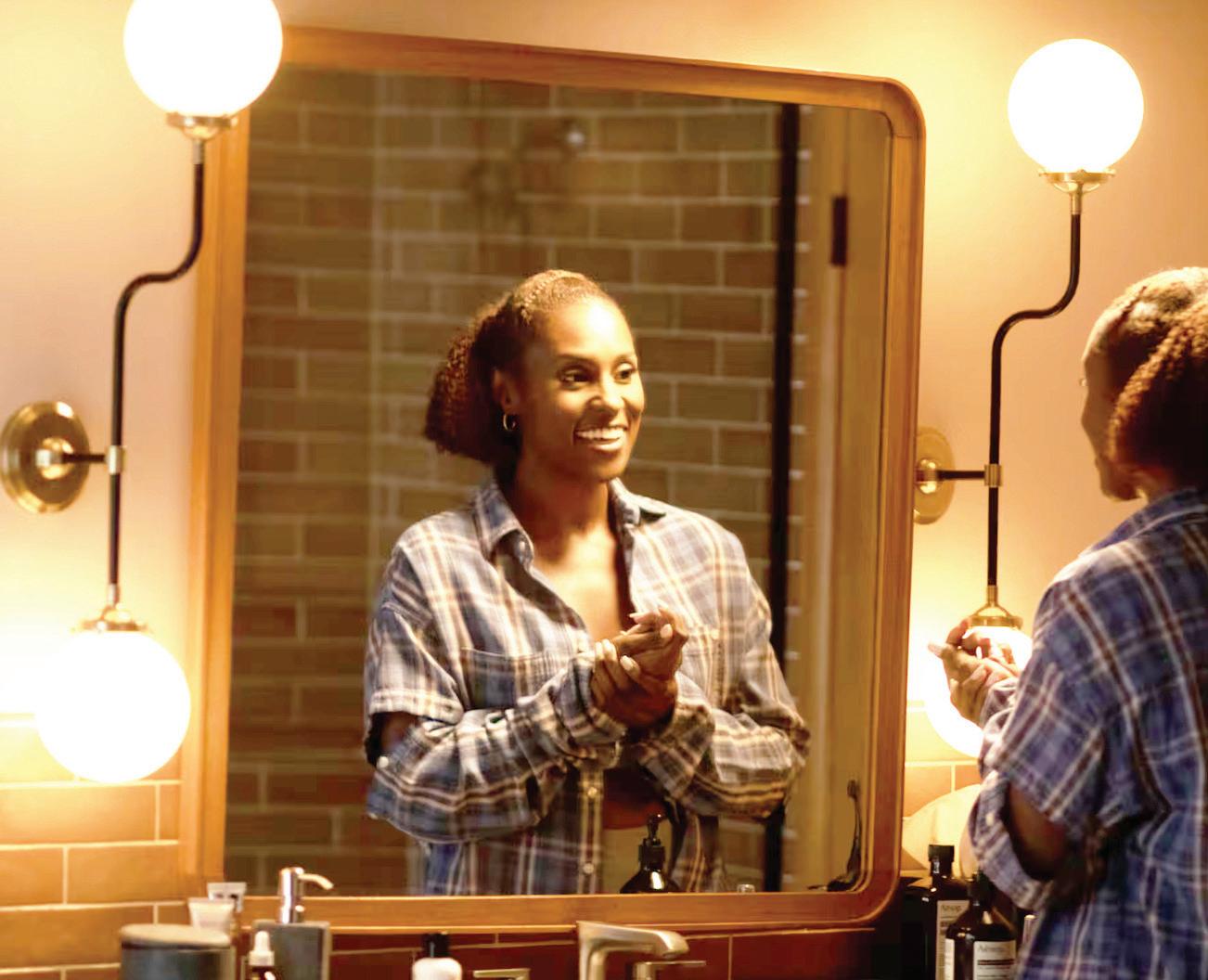
space for celebration and reclamation. “I really appreciate seeing Black women get their flowers, specifically how social media showcases the achievements and shows you what’s possible for yourself,” said community member Yurrea Armstrong.
“But [mainstream media] makes it seem like Black people are ratchet, uneducated, and merely criminals. The media tries to portray us as low level and incompetent. It makes me feel like I have to act a certain way in public to not be perceived as ghetto.”
From a systemic lens, the pressure to conform extends beyond external judgment — it also can be perpetuated within the Black community itself. “Within the Black community there is pressure to present yourself a certain way with name-brand clothes and materials to appear like you have money, and if you don’t, you are made to feel like an outcast,” Armstrong added.
However, some Black women refuse to let societal narratives define them. “When you have self-awareness and resilience, the media can push narratives, but when you truly know yourself, it doesn’t de-
fine you. You see through the unrealistic portrayals — the body trends, the stereotypes, the way they frame Black women. It’s all just noise if you don’t let it in,” said community member Chrissy Morris.
For her, knowledge of self keeps her grounded in her identity: “Being culturally aware is a strength, especially as a Jamaican American in a place like Minnesota, where you might feel like you stand out. Adapting to your surroundings is a survival skill, but at the core, it’s about staying true to who you are. At the end of the day, the media doesn’t shape you — you shape you and your experiences shape you.”
The issue of representation runs even deeper when considering colorism and the preference for Eurocentric beauty standards. Media portrayals have long established a standard of beauty that privileges lighter skin, looser curls, and features deemed “softer.”
We see this in casting when darker skin Black men are cast with a lightskin counterpart in shows like “Martin,” “The Fresh Prince of Bel-Air,” “Everybody Hates Chris” to name a few. This preference influences not only self-image but


dating experiences as well.
“Colorism is more than just physical appearance. It’s about seeing, choosing and valuing others. When the media continues to elevate Eurocentric beauty standards, it insidiously sends a message that darkerskinned women are less desirable, valuable and worthy. This messaging doesn’t leave its impact on-screen; it affects self-esteem, romantic experiences and expectations,” Inyang explained.
Many Black women have felt the impact of desirability politics, even when it comes to their own features. “I think that a lot of people back in the day did center Eurocentric standards, but now I feel like everyone is going after the ‘Black look.’ Today Black women are in a position where they are competing with women of other races to look like themselves,” said Armstrong.
“As Black women, full lips and big behinds are our stereotypical trademark features, so when you have thinner lips and a more petite body it’s almost like you don’t meet the status quo,” said Inyang.
Beyond beauty standards, the portrayal of Black women in media also affects relationship dynamics. “The way the media portrays us affects our relationships with each other. We find that men are looking for a woman that looks a certain way, centered on sexual attractiveness.
“The media dictates what type of Black woman you should have in this way when it oversexualizes us, giving screentime only to those who have artificial body enhancements. This is not allowing us to love each other for who we are and it’s taking away respect. Men are treating us like we are not enough for them.”
Despite these challenges, Black women continue to redefine beauty, worth and self-love on their own terms by refusing to be boxed into media portrayals that do not serve them, carving out spaces where their voices, stories and truths take center stage. Black women continue to advocate their intellect, natural beauty and diversity as a means of perseverance. Through platforms like social media, independent media outlets, and community-driven storytelling, Black women are not only demanding better representation but are also creating it themselves. The power of the media may shape perceptions, but ultimately, Black women are the authors of their own narratives.
Kiara Williams welcomes reader responses at kwilliams@ spokesman-recorder.com.
us know you’ll be there! saintpaul.edu/OpenHouse

As the Minnesota Spokesman-Recorder celebrates its 90th Anniversary year, you’re invited to commemorate this historic milestone by donating $90 to celebrate 90 years of continuous publication.
As a “$90—for- 90” contributor (non-business), your name will be prominently displayed in our print and digital editions until the week of Aug. 10, 2025. The paper was founded on Aug. 10, 1934.
or email admin@spokesman-recorder.com.
Anita Alexander
Torrion Amie
Holly Andersen
Nancy L. Beals
Jonathan Beck
Clara Boykin & Family
Gretchen Bratvold
Amanda Brinkman
Toweya Brown-Ochs
Benjamin F. Bryant
& Dr. Antusa S. Bryant
Deanna Callender
Shirlee L. Callender
Karl Cambronne
Liam Cavin
Janis Clay
Edward Coblentz
Coventry Cowens
Alvin E. Cunningham
Michael Davis
Victoria Davis
Marie Denholm
Michael Diehl
April A. Estes
George Ewing
Elizabeth Fealey
David Fettig
Readus Fletcher
Ken Foxworth
Michael Franks
Lee Friedman
Ella Gates-Mahmoud
Kimerlie Geraci
Erick Goodlow
Leota Goodney
Karlene Green
Pamela Hall-Clemens
Charles Hallman
Jeana Hamm
Hendon Group, Inc
Thomas Hill
Maxine & Kieran
Hughes
Ellen Guettler
& Ben Pofahl
Colnese Hendon
Connie Hudson
Angelo Hughes
Andrew Issacson
Katie Izzo
Ms. Jewelean Jackson
& Sir Steven C. Davis
Nina Johnson
Clarence Jones
Debra Jones
Shirley R. Jones
Julie July
Cynthia Kelly & Murry Kelly Jr.
Nathaniel Khaliq
Zena Kocher
Jimmy Lewis
Lisa Lissimore
Michele Livingston
Harlan Luxenberg
MRPP and Associate
Communications
Melanie Manaen
Rose McGee
Peter McLaughlin
Jeffrey McVay
Kyle Meerkins
Deborah Montgomery
Debbie Morrison
Marcia Murray
Mary K. Murray Boyd
Dan Ness
Sanda Noy
Amethyst O’Connell
The O’Neill Family
Minister Dr. Ni Ora Hokes
Liz Oppenheimer & Jeanne Burns
Tamara Pollard
Ray Seville Productions
Mary Quinn McCallum
Dr. Mitchell Palmer
McDonald
Heidi Pemberton
Amy Pfankuch
Patty Ploetz
Catherine Pruszynski
Mark Ritchie
Lyn Rabinovitch & John Saxhaug
Augustus Ritemon
Carolyn Roberson
Winthrop & Barbara Rockwell
M. Rebecca Ross
St. Paul Saints
Anura Si-Asar
Floyd Smaller
Chanda Smith Baker
South Hill Film
Ronald Spika
Stan Sandiford
Cyriaque Sukam
Timothy Sullivan
Heidi Swank
Gregory Tillman
Dotty Timmons
Nicholas Upton
Jason Walker
Dr. Betty Webb
Bill Wells
Tracy Wesley
Jeffery Young
By Vickie Evans-Nash Contributing Writer
C.H.I.L.L. stands for Community Helps Individuals Live and Learn. The MN CHILL Foundation’s motto is “If not me, then who?” The founders, William “Chuck” Hill and Cynthia “Cindy” Hill, help parents steer their children toward a successful future.
The Hill’s service to the community began through sports. Chuck was a basketball coach, and all three of their children played basketball, one professionally. After school, on weekends, and during tournaments, team members would come to their home needing homework help. That’s when Cindy stepped in.
“Being a basketball organization is more than just dribbling that ball,” she says. “You’ve got to have your grades in place… because GPA matters for entering the NCAA.”
After years of supporting students, their son suggested they start a foundation. In 2014 they became a nonprofit organization with five graduating classes from the program.
“The first year we had a 98% rate of the players that graduated out of our program that went to college on an academic or athletic scholarship,” says Cindy. “The last four years we have had 100%.”
For 34 years, the Hills owned and operated Programming Solutions, an IT company. Some of the profits from this
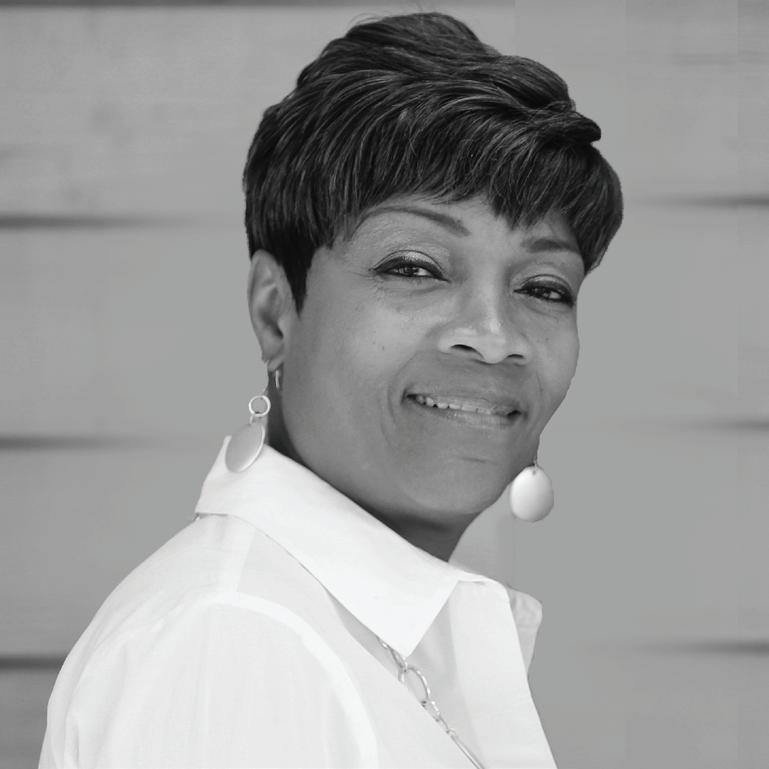
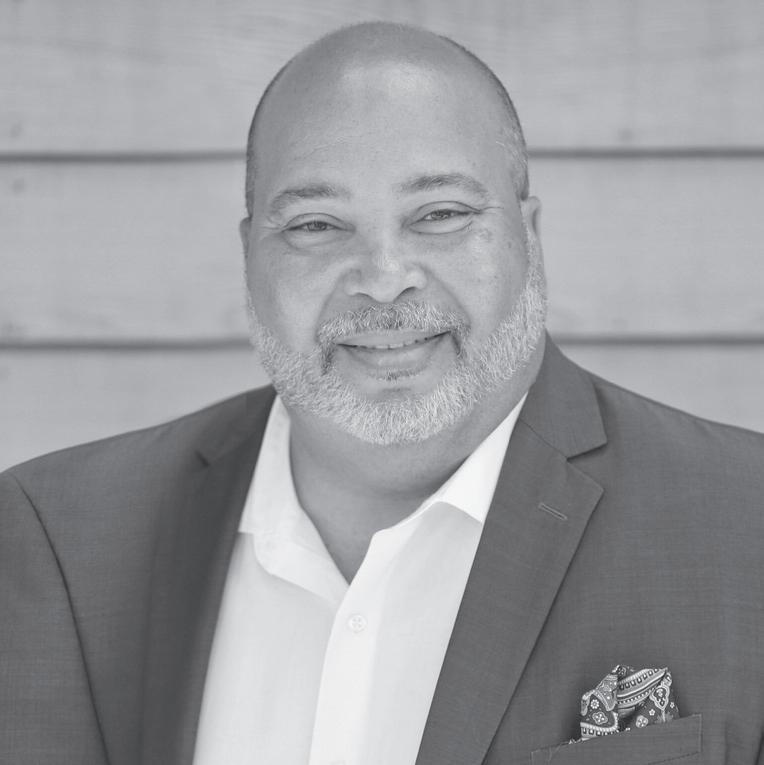
jobs can start at $75,000 per year. They include cyber security and AI.
During her years in the IT industry, Cindy is often the only person of color in the room and the only female. She would like to see these positions filled with more women and people of color.
expanded space dedicated to teens. The Hills want to include a college readiness program at the site.
business were used to support students. Their fundraising efforts covered other costs.
Wanting to impact children before entering high school, in 2016 they developed Chill Fitness for Kids. It began at the Martin Luther King Center in St. Paul to combat childhood obesity and diabetes. Fitness can also help children with ADHD.
need some support in different areas which will also help the child.”
The program became a part of the Freedom School Express’ summer session. They expanded to Benjamin E. Mays IB World School, Capitol Hill Magnet School, and Hazel Park Academy. They offer guidance and instruction from
“The first year we had a 98% rate of the players that graduated out of our program that went to college on an academic or athletic scholarship.”
“In the school system, they push [medication] first instead of finding out what’s the root of the problem,” Cindy says.
“They don’t take the time to find out [that] home just may
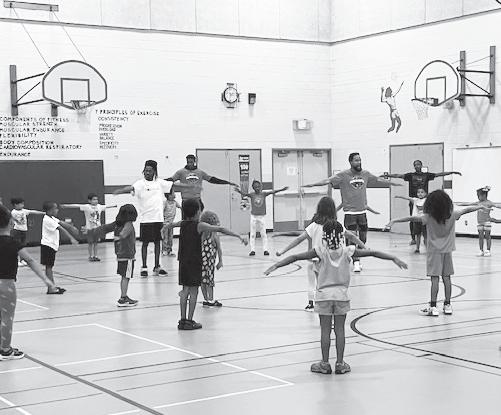
a licensed therapist and a nutritionist.
Cindy recalls seeing a billboard on Hwy 94 that ranked Black students in Minnesota close to the bottom along with Alabama and Mississippi in school test scores. Partly in response to this billboard, they developed an academic program at Freedom School.
During the first week, staff tested students’ reading and math levels. Those far behind academically worked in groups with a 1-4 teacher/student ratio learning the basics. Not only did they support students through the summer; they also checked the school year’s test scores to see if scores improved. They did.
“That just lets us know that the curriculum that we put together does work,” says Cindy.
The St. Paul Promise Neighborhood helps support this programming in schools.
Before 2019, they had never written a grant. In 2019, at the urging of those wanting the programs to expand, they applied for a grant with The St. Paul Foundation. They became their first big sponsor.
Covid brought the programs to a halt, but only temporarily. They reached out to families through YouTube.
“Part of the exercising also involves the parents. You have to [get] the whole family involved,” Cindy says. “And the same thing on the nutrition side, because the kids aren’t the ones buying the food.”
During the mandatory school lockdown, 273 parents continued the programs online.
If supporting students through school isn’t enough, the Hills reach young adults through their Chill Tech program. It’s a 10-week paid internship offered on Sundays for 16and 17-year-olds, and a second group for 18- to 24-year-olds. Students are introduced to jobs in the IT industry.
“There are a lot of good paying jobs that you don’t have to have a college degree to do, but you do have to have a certification,” says Cindy. These
They would also like to have a greater impact on their Brooklyn Park Community, where they have lived and been business owners for over three decades. Cindy says Brooklyn Park’s high crime rate among youth is partly related to few safe and engaging alternatives for teens.
In 2023, MN Chill dedicated a Chill Tech lab to the Zanewood Recreational Center. Limited space in the facility meant they had to share a multipurpose room. So, they can’t schedule regular weekly programming.
“The rec center that we have is for our younger youth plus the teens. They are busting out at the seams,” says Hill.
This past January, they received a $100,000 grant from Thielen Foundation for programming in a $10 million
“One of the reasons why we started the Chill Tech program is because we wanted the school to uplift students that choose to go to a trade school just as much as they do the students that go to a two-or-fouryear college or university,” she says. “The end result is to make sure that they have the tools that they need to be successful in life however that may look.”
On June 30 they will hold their annual golf tournament at the Green Haven Golf Course in Anoka. “We are looking for volunteers, golfers and sponsors,” Cindy says.
“We rely on the funding from this event to support our yearround programming.”
They are always looking for volunteers and financial support from community members who share their vision of helping families and children.
“We don’t do it for the accolades,” says Cindy. “We do it because it needs to be done.”
For more information, go to minnesotachillfoundation.org.
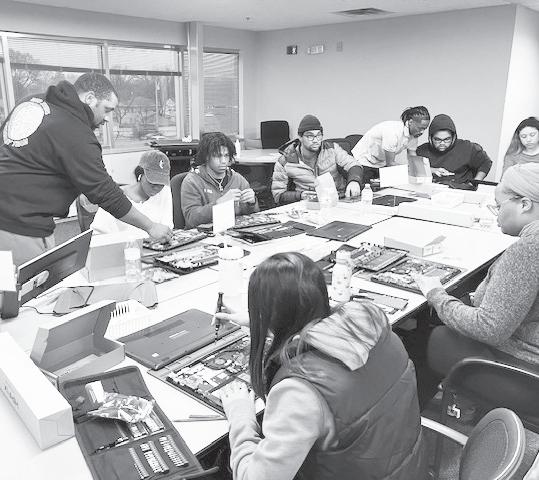
performers.
anywhere anytime soon.”
Stillman coaches work with team day in, day out
Stillman College Assistant Coaches KaTia May (WBB) and Montego Hoskins (MBB) each were named the HBCUAC Assistant Coach of the Year respectively.
“I wouldn’t say surprising,” May said when asked on winning the award, “simply because of the work that we put in. So, it didn’t surprise me at all.”
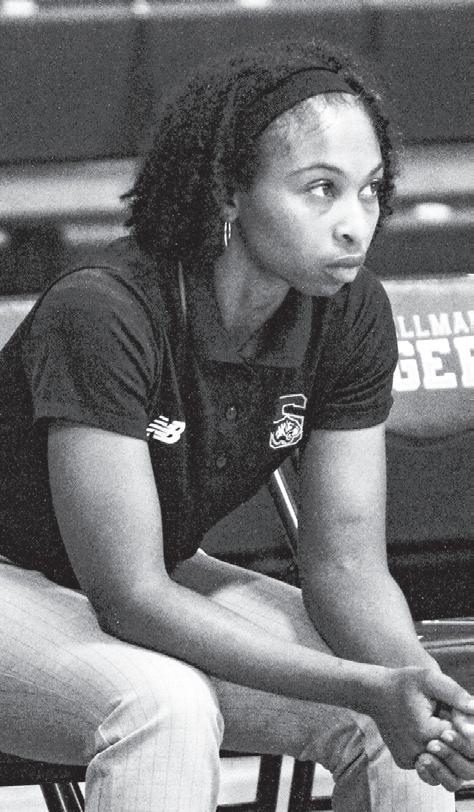
Both Tigers teams won the conference’s East Division and both clinched the tournament’s overall No. 1 seed and automatic bids in the NAIA tournament.
The Stillman women this season set a program record for most wins and tops in conference scoring (71.2 ppg) and third in points allowed (57.5 ppg).
The school’s men’s team won a conference title for the first time since 2021. The Tigers held opponents to 69.9 ppg, fourth best in the HBCUAC, and fourth in the conference with a 33.9 rebounding per game average.
“Just working day in, day out with the team,” said Hoskins, who is a former Stillman player (2016-18) and graduated with a health and physical education/fitness degree. “Just preparing them for the next game. Just being able to motivate them and stay on them, and make sure everything has been alright.”
Finally…
The two Stillman squads, Dillard (men) and Philander Smith (women), all are playing this week in NAIA tourna-
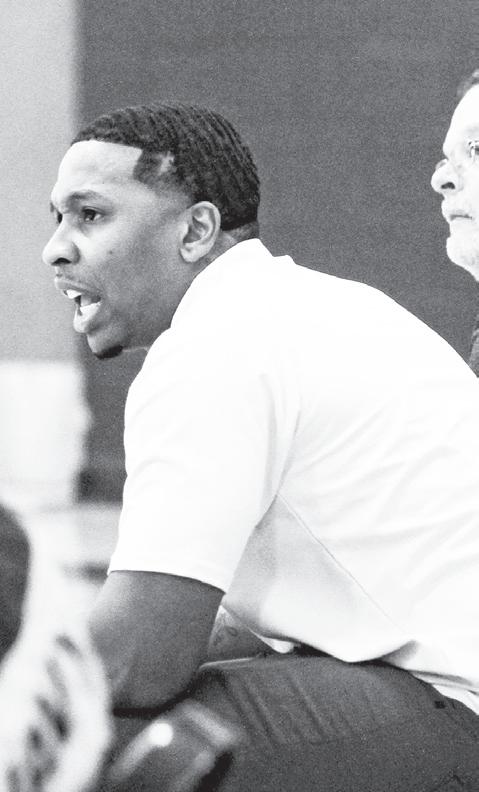
Courtesy Stillman College Athletics
ment opening round contests. No. 11 Stillman plays No. 1 Louisiana State University, and No. 15 Dillard plays No. 2 William Woods (Mo.) University on March 14 in the men’s bracket. No. 11 Stillman plays No. 6 University of Rio Grande (Ohio), and No. 16 Philander Smith plays No. 1 Indiana Wesleyan University on March 14. All four HBCUAC teams are vying for the NAIA finals later this month.
Charles Hallman welcomes reader comments to challman@ spokesman-recorder.com.
A walk-on after graduating from Minnesota Duluth, Strong was voted a co-captain by his Howard teammates this season. He is the only Division I active player in law school, now in his second year.
“He’s a big part of our team,” said Howard MBB Coach Kenneth Blakeney of Strong. “He absolutely is killing it in law school right now. I’m just so proud of him on and off the court.”
Other players to watch: WBB – Diamond Johnson (Norfolk St.), Ericka Huggins (Delaware St), Laila Lawrence and Angel Jones (Coppin St), and Destiny Howell, Zennia Thomas, and Saniyah King (Howard).
MBB – Blake Harper (Howard), who is leading the MEAC in scoring and second in rebounding and is being projected as the league’s top freshman and possibly top player when the individual honors are handed out.
According to his coach, Harper played behind several stars on his high school team last season. “Twelve months ago, he was coming off the bench at Gonzaga High School here in Washington, D.C.,” continued Blakeney.
“To see his transformation from then to now, and how hard he’s worked, as well as how he’s playing, he’s an
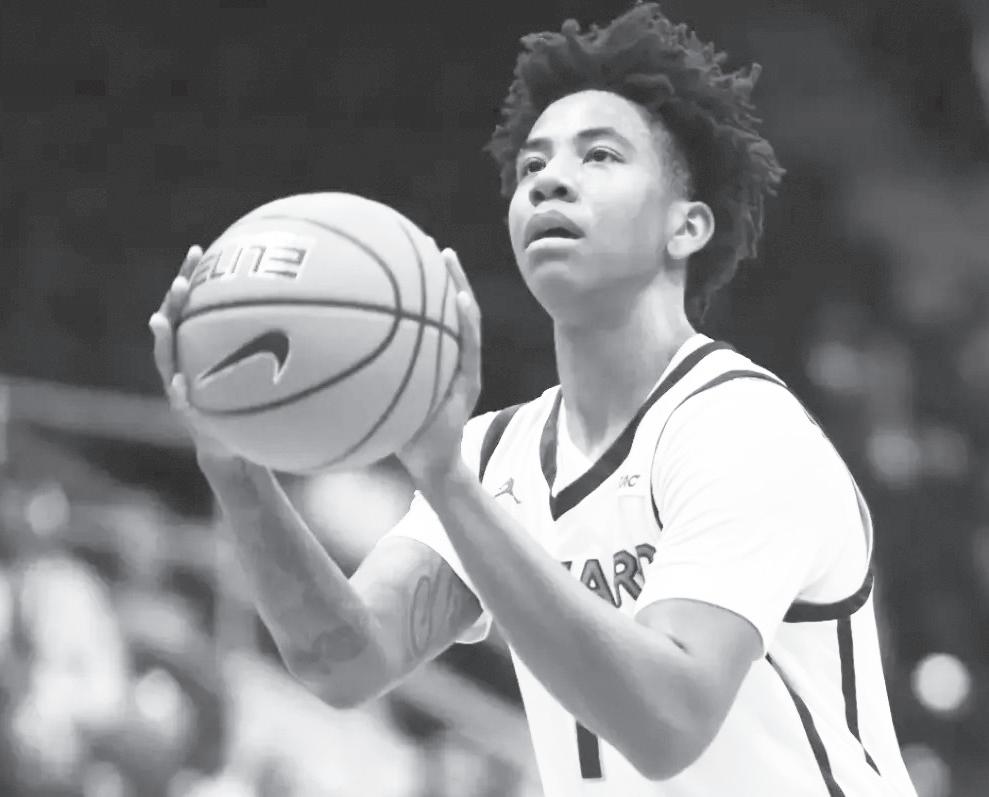
even better young man.”
“The game is so new to him, so fresh. He had to fight and earn opportunities,” noted Blakeney. “I’m proud of how he handles success. He should be player of the year.”
Here are the tournament pairings: WBB – No. 1 Norfolk State vs. No. 8 South Carolina State, Friday, March 12, 12 noon local time; No. 2 Howard vs. No. 7 Delaware St. immediately following game one. Thursday, March 13 – No. 4 Coppin St. vs. No. 5 North Carolina Central; No. 3 Maryland Eastern Shore vs. No. 6 Morgan State — game times at 12 noon and 2 pm local time.
Semifinals are scheduled on Friday and the title game on Saturday.
MBB – No. 1 Norfolk St vs. No. 8 Maryland Eastern Shore, Wednesday, March 12, 6 pm local time; No. 2 South
Carolina State vs. No. 7 Coppin State immediately after the first game. Thursday, March 13 – No. 3 Delaware St vs. No. 6 North Carolina Central, 6 pm local time; No. 4 Howard vs. No. 5 Morgan St immediately after the first game. Semifinals are scheduled for Friday and the championship game on Saturday.
Finally…

By Kiana Cox, Besheer
Mohamed and Justin Nortey Pew Research Center
The relationship between Black Americans and the Republican Party has drawn considerable attention in recent years. Discussions have ranged from why Black men voted for Donald Trump at higher rates than Black women in the 2020 presidential election to more recent debates about Black pop culture and the appeal of GOP-aligned candidates in both national and local politics.
The partisan balance among Black adults in the United States is little changed over the last several decades, but it shifted substantially in the mid-20th century. In the 1930s, Black adults were just as likely to support the Republican Party as the Democratic Party.
The share of Black adults who affiliated with the GOP started to decline in the 1940s, particularly after President Harry S. Truman, a Democrat, issued an executive order to desegregate the U.S. military in 1948. This shift was solidified after the passage of the Civil Rights Act under Democratic President Lyndon Johnson in 1964.
Today, only about 1 in 10 Black adults identify with or lean toward the Republican Party. And in a Pew Research Center survey in October, only 4% of Black registered voters said they would vote for the Republican candidate for the U.S. House seat in their district, while 69% said they would back the Democratic candidate.
When it comes to their views on race, Black Republicans differ from Black Democrats in one key way: They tend to support individualistic approaches to addressing
racial inequality, while Black Democrats tend to support institutional approaches.
For example, Black Republicans and those who lean to the GOP are more likely than Black Democrats and Democratic leaners (59% vs. 41%) to say that the bigger problem for Black people is racist acts committed by individual people, as opposed to racism in our laws. And they are less likely than Black Democrats to support complete institutional overhauls to the prison system (35% vs. 57%), policing (29% vs. 52%) and the judicial process (35% vs. 50%) to ensure fair treatment of Black people.
Black Republicans are younger than Black Democrats, as well as White Republicans. Around 3 in 10 Black Republicans (28%) are ages 18 to 29 — higher than the share among Black Democrats (17%) and white Republicans (10%).
Black Republicans are less likely than Black Democrats and white Republicans to be 65 and older: 9% are in this age group, versus 18% of Black Democrats and 28% of white Republicans.
Black Republicans are much more likely than white Republicans (50% vs. 18%) to live in lower-income households.
As is the case among Black Democrats, roughly half of Black Republicans live in the South. Black Republicans are about as likely as Black Democrats to live in Southern states (52% vs. 56%), but more likely than white Republicans (38%) to do so. Black Republicans are less likely than white Republicans to live in the Midwest (17% vs. 27%) or the West (13% vs. 20%).
Black Republicans are less likely than Black Democrats to attend Black churches. In both parties, most Black adults identify as Protestant. However, Black Republicans are less likely than Black Democrats (22% vs. 34%) to attend predominantly Black Protestant churches. Black Republicans and Democrats are about as likely to be Catholic (6% each) or religiously unaffiliated (24% vs. 21%).
Black Republicans are less likely than Black Democrats to say being Black is a significant part of their personal identity. While about 6 in 10 Black Republicans (58%) say
When it comes to their views on race, Black Republicans differ from Black Democrats in one key way: They tend to support individualistic approaches to addressing racial inequality, while Black Democrats tend to support institutional approaches.
Black Republicans have a similar income profile to Black Democrats. Black Republicans are about as likely as Black Democrats to live in upper-income (12% vs. 10%) or middle-income households (37% vs. 40%). And roughly half of both groups live in lower-income ones. However,

Or,
“The limits of tyrants are prescribed by the endurance of those whom they oppress.”
—Frederick Douglass
By Raymond Nat Turner
Vampire Ponzi-schemers pigging out on blood and Sweat in our tax trough of trillions? Who are these AI monsters with mythical Midas touches? How many Lives have their ill-gotten gains cost? How many more?
Who’s the Hitler-loving, morally bankrupt, spiritual Pauper posing as the world’s richest human? Who’s the Wild Boer-Afrikaner loading loot into big, bulging Apartheid carryon bags?
Who’s the stealth — Self-selected, Apartheid-infected — Un-elected, disconnected, misdirected—Un-vetted Un-Marie Antoinette-ed …Parasite — playing Freddo’s Puppet-master? Who’s the grifter treating lives like emojis?
Which white supremacist devil — Afrikaner — reengineered Hell with assembly lines? Dropped apartheid into Alameda County? How many bleeding ulcers did each billion cost us?
How many heart attacks? Strokes? How much self-medication?
How many Tequila shots? How many black eyes? How many busted lips? Broken jaws? Restraining orders? Divorces? Broken homes and ugly Custody battles? How many foreclosures? How many tattered tarps, Torn tents and cardboard mattresses did each of his billions cost us?
By the way, MrMu***ukkka: “What did YOU do last week —” Besides put on pants — one leg at a time — and prance like a Peacock polluting our planet with the sulfur stench of greed?
“What did YOU do last week —” justifying space on this Earth?
“What did YOU do last week —” in masturbatory bully mode — Besides stuff sneering champagne-caviar-hole? Besides defecate Firings on federal workers’ heads? Besides flood zones with nazi dreck? Besides metastasize cancer of cruelty in MAGAt minds? Besides breed greed?
“What did YOU do last week —” except peer up at the stars — And Not be humbled? Except piss off hand-to-mouth, unhealed, unhoused Everyday people? Except father your own gravediggers; and teach Marx Better than a thousand Harvard, Yale and Princeton professors combined?
“What did YOU do last week —” Except confirm we can no longer Afford You; And your dim, sunless vision and want you gone? Want you gathering Your Boys From Brazil/Hitlerite-hackers; Want you boarding your boy toy And blasting off! (Note: Sun Ra don’t want you on Saturn; And Martians don’t play)
© 2025. Raymond Nat Turner, The Town Crier. All Rights Reserved.
Raymond Nat Turner is a NYC poet; BAR’s Poet-in-Residence; and founder/co-leader of the jazzpoetry ensemble UpSurge!NYC.
By April Ryan
submissions@spokesman-recorder.com
submissions@spokesman-recorder.com
ads@spokesman-recorder.com
submissions@spokesman-recorder.com.
being Black is an extremely or very important part of how they think about themselves, an even larger share of Black Democrats (82%) say the same. Black Republicans are also more likely than Black Democrats (21% vs. 6%) to say Blackness is a little or not at all important to how they think about themselves.
Black Republicans are about as likely as Black Democrats to see their ancestry as important to how they see themselves. Black Republicans are just as likely as Black Democrats (66% vs. 65%) to say their ancestry is an extremely or very important part of their personal identity. They are also about as likely as Black Democrats to know that their ancestors were enslaved (54% vs. 59%) and to speak to their relatives about their family history (78% vs. 77%).
Black Republicans are less likely than Black Democrats to express a sense of “linked fate” with Black people in the U.S. About 4 in 10 Black Republicans (39%) say that everything or most things that happen to Black people in the U.S. will affect their own lives.
A larger share of Black Democrats (57%) say the same.
Black Republicans are about as likely as Black Democrats to report frequent experiences of discrimination.
As this nation observes the 60th anniversary of Bloody Sunday in Selma, Alabama, the words of President Trump reverberate: “This country will be WOKE no longer,” an emboldened Trump offered during his recent speech to a joint session of Congress. Since then, Alabama Congresswoman Terri Sewell posted on the social media platform formerly known as Twitter this morning that “Elon Musk and his DOGE bros have ordered GSA to sell off the site of the historic Freedom Riders Museum in Montgomery.”
Her post of little words went on to say, “This is outrageous and we will not let it stand! I am demanding an immediate reversal. Our civil rights history is not for sale!” (Search “DOGE trying to sell Freedom Rider Museum.”)
Also in recent news, the Associated Press is reporting they [DOGE] have a file of names and descriptions of more than 26,000 military images flagged for removal because of connections to women, minorities, culture or DEI. In more attempts to downplay
About 8 in 10 Black Republicans (79%) say they have personally experienced discrimination because of their race or ethnicity. This includes 20% who say they have experienced discrimination regularly and 59% who say they have experienced it from time to time. Similarly, 80% of Black Democrats report experiences of racial discrimination, either regularly or from time to time. Black Republicans differ from Black Democrats in their views on racial discrimina-
Blackness, a word that is interchanged with woke, Trump supporters have introduced another bill to take down the bright yellow letters of Black Lives Matter Plaza in Washington, D.C., in exchange for the name Liberty Plaza.
D.C. Mayor Morial Bowser is allowing the name change to keep millions of federal dollars flowing there. Black Lives Matter Plaza was named in 2020 after a tense exchange between President Trump and George Floyd protesters in front of the White House. There are more reports about cuts to equity initiatives that impact HBCU students. Programs that recruited top HBCU students into the military and the pipeline for Department of Defense contracts have been canceled.
Sunday in Selma, several Congressional Black Caucus leaders are reintroducing the Voting Rights Act.
26,000 military images are flagged for removal because of connections to women, minorities, culture or DEI.
Meanwhile, Democrats are pushing back against this second-term Trump administration’s anti-DEI and anti-woke message. In the wake of the 60th anniversary of Bloody
tion as a barrier to progress
Despite experiencing racial discrimination at similar rates, Black Republicans and Democrats differ in how they view its effects. Black Republicans are less likely than Black Democrats (44% vs. 73%) to say racial discrimination is the main reason Black people can’t get ahead in the U.S., and they are more likely to say Black people who can’t get ahead are mostly responsible for their own condition (45% vs. 21%).
South Carolina Democratic Congressman James Clyburn and Alabama Congresswoman Terry Sewell are sponsoring H.R. 14, the John Lewis Voting Rights Advancement Act. Six decades ago, Lewis was hit with a billy club by police as he marched for the right to vote for African Americans. The right for Black people to vote became law with the 1965 Voting Rights Act that has since been gutted, leaving the nation to vote without the full protections of the Voting Rights Act. March 1, 2020, a few months before his death, Lewis said, “We need more than ever in these times many more someones to make good trouble — to make their own dent in the wall of injustice.”
April Ryan is a reporter for the NNPA Newswire. Reach her at @AprilDRyan.
Black Republicans are just as skeptical as Black Democrats about the prospects for equality. Black Republicans are about as likely as Black Democrats (39% vs. 45%) to say equality for Black people in the U.S. is a little or not all likely. In fact, only about 15% of Black adults in either partisan coalition say equality for Black people is extremely or very likely.
Center.
From Ads Department/MN Spokesman-Recorder
PHONE: 612-827-4021
FOR BILLING INQUIRIES & TEARSHEETS
PLEASE CONTACT
ACCOUNTING DEPT
BILLING@SPOKESMAN-RECORDER.COM
SUMMONS 3 WEEK RUN FLAT RATE: $320
Please Note: New email address for all future ads is ads@spokesman-recorder.com
MN 55101
If you fail to respond, judgment by default may be entered against you for the relief demanded in the complaint. You also must file your answer or motion with the court.
Date of Issuance: January 31, 2025
The MSR handles billing digitally. This means you will get e-tears and e-mailed invoices unless you specifically request a hard copy.
Minnesota Spokesman-Recorder March 13,20,27 2025
Complaint. In your Answer you must state whether you agree or disagree with each paragraph of the Complaint. If you believe the Plaintiff should not be given everything asked for in the Complaint, you must say so in your Answer.
4. YOU WILL LOSE YOUR CASE IF YOU DO NOT SEND A WRITTEN RESPONSE TO THE COMPLAINT TO THE PERSON WHO SIGNED THIS SUMMONS. If you do not Answer within 20 days, you will lose this case. You will not get to tell your side of the story, and the Court may decide against you and award the Plaintiff everything asked for in the complaint. If you do not want to contest the claims stated in the complaint, you do not need to respond. A default judgment can then be entered against you for the relief requested in the complaint.
5. LEGAL ASSISTANCE. You may wish to get legal help from a lawyer. If you do not have a lawyer, the Court Administrator may have information about places where you can get legal assistance. Even if you cannot get legal help, you must still provide a written Answer to protect your rights or you may lose the case.
6. ALTERNATIVE DISPUTE RESOLUTION. The parties may agree to or be ordered to participate in an alternative dispute resolution process under Rule 114 of the Minnesota General Rules of Practice. You must still send your written response to the Complaint even if you expect to use alternative means of resolving this dispute.
Dated: 1/31/2025
By:____________________
BRANTINGHAM LAW OFFICE
Jeremy L. Brantingham, MN #0299558 2200 E. Franklin Avenue, Suite 202 Minneapolis, MN 55404 (612) 339-9700
ATTORNEY FOR PLAINTIFF Minnesota Spokesman-Recorder February 27 & March 6, 13, 2025
Continued from page 12
basketball conference. It’s almost like the old Big East back in the day. You will always get high quality competition.”
Dr. Kiki Baker Barnes has been in charge of the HBCUAC, first as interim commissioner, then given the job full time in 2022. She is the conference’s first Black woman to lead the conference and the only Black woman commissioner in the NAIA.
Baker Barnes’ leadership has received rave reviews, which has included conference expansion (now at 13 schools — Stillman and Uni -
versity of the Virgin Islands are the latest members) and name changing from the Gulf Coast Athletic Conference to its present name last year.
“What I’m getting in terms of feedback from the coaches and the athletes is it’s good,” said the commissioner of the recent event in Tuscaloosa. “The Visit Tuscaloosa team and Stillman College are the ultimate hosts. They have done a fantastic job in organizing this and making it a top quality event and experience for all involved.”
Charles Hallman welcomes reader comments to challman@ spokesman-recorder.com.

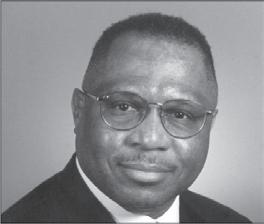
STATE OF MINNESOTA FOURTH JUDICIAL COUNTY OF HENNEPIN DISTRICT COURT PROBATE MENTAL HEALTH DIVISION
In Re: Estate of
NOTICE OF INFORMAL PROBATE OF WILL AND CODICIL AND APPOINTMENT OF PERSONAL REPRESENTATIVE AND NOTICE TO CREDITORS
Margaret Rees Schorsch, FILE NO. 27-PA-PR-25-224 Deceased
TO ALL INTERESTED PERSONS AND CREDITORS:
Notice is hereby given, that an application for informal probate of the above named decedent’s last will dated October 23, 1989 and codicil dated May 2, 2000 have been filed with the Registrar herein, and the application has been granted informally probating such will. Any objections may be filed in the above, and the same will be heard by the Court upon notice of hearing fixed for such purpose.
Notice is hereby further given that informal appointment of Joanne Rees Vance, whose address is 8317 W 103rd St, Bloomington, MN 55438, as personal representative of the estate of the above-named decedent, has been made. Any heir, devisee or other interested person may be entitled to appointment as personal representative or may object to the appointment of the personal representative and the personal representative are empowered to fully administer the estate including, after 30 days from the date of issuance of letters, the power to sell, encumber, lease or distribute real estate, unless objections thereto are filed with the Court (pursuant to Section 524.3607) and the Court otherwise orders.
Notice is further given that ALL CREDITORS having claims against said estate are required to present the same to said personal representative or to the Probate Court Administrator within four months after the date of this notice or said claims will be barred.
Dated: March 03, 2025 Lindy Scanlon Registrar
ProSe Sara Gonsalves District Court Administrator Minnesota Spokesman-Recorder March 13, 20, 2025
CLIENT ACCOUNT REPRESENTATIVE:
Wilson Law Group LLC seeks a Client Account Representative in Minneapolis, MN. Duties include: open and update client accounts; program billing payment plans; generate monthly invoices and account statements; respond to inquiries; record client payments and prepare deposits for bank processing. Associate’s degree in accounting, business administration, or related major is required. Alternatively, we will accept a high school diploma and 12 months of experience in a similar position. Fluency in Spanish is required. Send resumes to Jessica Westendorp at 3019 Minnehaha Ave, Minneapolis, MN 55406 or via email at jwestendorp@wilsonlg.com.
Minnesota Spokesman-Recorder March 13, 20, 2025

From Ads Department/MN Spokesman-Recorder PHONE: 612-827-4021
FOR BILLING INQUIRIES & TEARSHEETS
PLEASE CONTACT ACCOUNTING DEPT @ BILLING@SPOKEMAN-RECORDER.COM
SUMMONS PREPAID FLAT RATE: $110 X 3 WEEK RUN TOTAL: $330
Please proof, respond with email confirmation to ads@spokesman-recorder.com
The MSR handles billing digitally. This means you will get e-tears and e-mailed invoices unless you specifically request a hard copy.
From Ads Department/MN Spokesman-Recorder
PHONE: 612-827-4021 FOR BILLING INQUIRIES & TEARSHEETS
IT Company (Plymouth, MN) seeks Systems Engineer to design and develop systems and database applications. Support full lifecycle using advance technologies such as Waterfall, Agile, Clear Case, Use cases, Workflow Management, UML, JIRA, HP, ALM, Rally, Confluence, etc. Validate developed products in test during each sprint and perform UAT and engage with the user. Create and assist in performing various types of tests. Perform troubleshooting. Generate customized reports. Offered salary: $115,045.00 to $116,000.00/year. Send resumes to: HRD, VITS Consulting Corp., 14264 23rd Ave N, Plymouth, MN 55447. Minnesota Spokesman-Recorder March 13, 2025
PLEASE CONTACT ACCOUNTING DEPT BILLING@SPOKESMAN-RECORDER.COM
PROBATE 2 WEEK RUN FLAT RATE $215.00 PREPAID
Please Note: New email address for all future ads ads@spokesman-recorder.com
Medtronic, Inc., Fridley, MN. Master’s deg. in Mechanical, Biomedical Eng. or closely rel. Eng. field & 2 yrs exp. as a Quality or Reliability Engr. in the medical device industry, or Bachelors deg. & 5 yrs. exp. Position works a hybrid model and will be onsite in Fridley, MN –3 days per week. Relocation assistance not available for this position. Apply at https://medtronic.wd1.myworkdayjobs.com/ MedtronicCareers, Req. #R22867. No agencies or phone calls. Medtronic is an equal opportunity employer committed to cultural diversity in the workplace. All individuals are encouraged to apply.
The MSR handles billing digitally. This means you will get e-tears and e-mailed invoices unless you specifically request a hard copy.
Minnesota Spokesman-Recorder March 13, 2025
PRINICPAL SOFTWARE ENGINEER: Medtronic, Inc., Minneapolis, MN. Multiple positions available. Position is open to telecommuting from anywhere in U.S. Req. Masters or foreign equiv. in Comp. Sci., Info. Tech., Software Eng., or rel. eng. fld & 2 yrs exp. as Software Eng./Developer or rel. occupation in Software App. Development OR Bachelors or foreign equiv. in Comp. Sci., Info. Tech., Software Eng., or rel. eng. fld & 5 yrs. exp. as a Software Eng./Developer or rel. occupation in Software App. Development. Apply at https://medtronic.wd1.myworkdayjobs. com/MedtronicCareers, Req. #R23234. No agencies or phone calls. Medtronic is an equal opportunity employer committed to cultural diversity in the workplace. All individuals are encouraged to apply.
From Ads Department/MN Spokesman-Recorder
Phone: 612-827-4021
FOR BILLING INQUIRIES & TEARSHEETS
PLEASE CONTACT ACCOUNTING DEPT BILLING@SPOKESMAN-RECRDER.COM
Minnesota Spokesman-Recorder March 13, 2025
EMPLOYMENT DISPLAY
SIZE: 2COL X 3.0 INCH
RATE: $44.60 PER COL. INCH FREQUENCY X2
TOTAL: $535.2
Please proof, respond with email comfirmation to ads@spokesman-recorder.com
The MSR handles billing digitally. This means you will get e-tears and emailed invoices unless you specifically request a hard copy.

outhern hospitality is not a myth or imaginary notion but a time honored practice still in effect. It’s been a couple of weeks since we spent a refreshing, interesting and memorable week for the first time watching good hoops at an all-Black tournament with Black folk all around in Tuscaloosa.
Here are some of the people we spent some time with during the 2025 Hope Credit Union HBCUAC Basketball Championships.
“I attended from ’84 to ’88. I graduated in ’88 and left for about a year,” said Stillman College grad Daphne

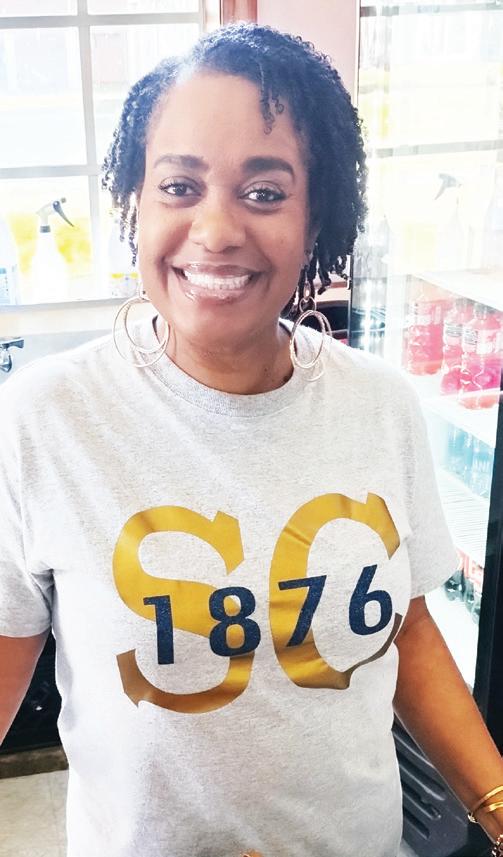
Hood, who during her threedecades-plus time at the small Black college has worked as a switchboard operator, account payable director, and now as administrative assistant to the athletic director.
“I came back and started working in November of ’89.” Hood also sells concessions at games at Birthright Alumni Hall.
Hood said of hosting the six-day hoops tournament for the second consecutive year, “It is very important for us because it brings recognition for the college. The tournament being here is bringing a lot of awareness to the institution, which is great.”
“The overall experience was really good for the players,” said Virgin Islands WBB Coach Stephanie Cooper. She and her team, along with the UVI men’s team, traveled nearly a day from St. Thomas to Tuscaloosa — over 1,000 air miles — for the games.
“It’s tough to really enjoy after you lose in the first round,” she told us after her team’s defeat to end their season. “But we are going to make the most

out of the experience.”
“The experience was honestly amazing,” added Kendallyn McCoy, a Talladega (AL) College sophomore guard. “Of course, I would have hoped for a different result, but I couldn’t ask anything more of my team
12:00 at St. Paul Harding High School
Ai’Jhon Douglas led the way with 18 points, Julius Terrell had 17, Salman Hussein added 16 and Tobis Williams added 12, leading Harding to a

75-55 win over Two Rivers in Class 3A Section 3 semifinals.
2:00 at St. Paul Johnson High School Kenny Turner’s putback as time expired lifted Johnson,
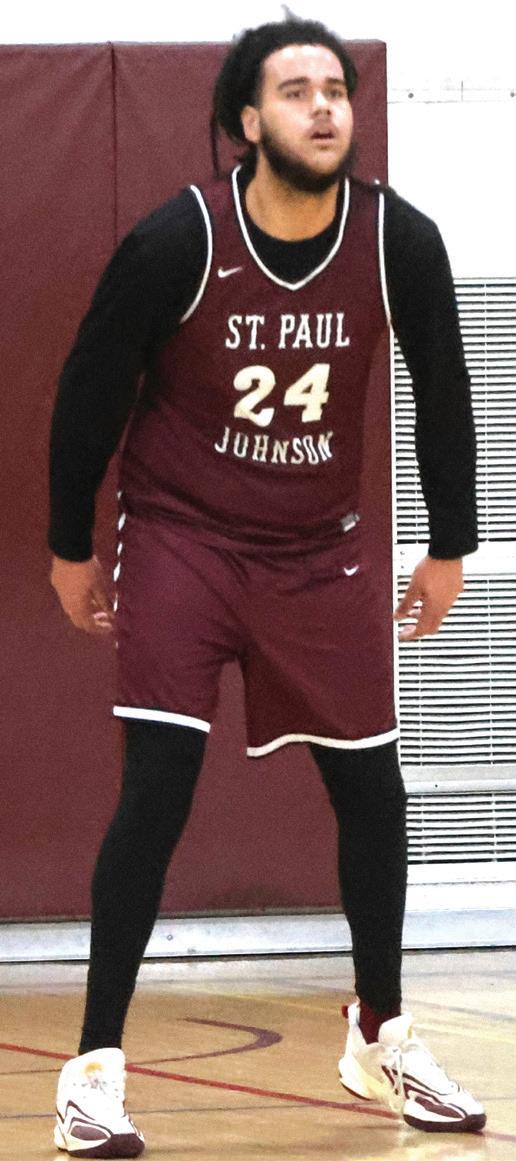
because of how hard we fought and the season overall.”
“I think the city is doing a great job trying to entertain us and provide different things for the conference,” Charlene Johnson, the Voorhees (S.C.) University athletic director, pointed out.
Hope Credit Union, the nation’s largest Black and woman-owned financial institution located in five Southern states, is a major sponsor for the HBCUAC post season tourney. “It was a no-brainer for us,” admitted Hope CU Vice-President of Marketing and Communications Holly Cooper on the partnership with the HBCUAC, which began in 2022 and was extended last year for two more years.
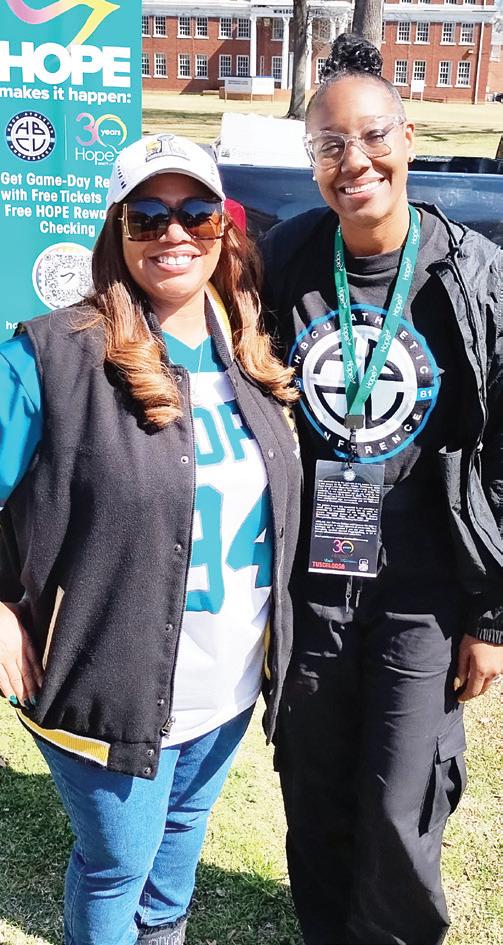
“This is a true partnership without a doubt. [We’re] not a title sponsor who just writes a check. No, we’re very hands on. We support each other outside of just the conference [tournament] time. It’s throughout the year.”
“It has always been a real strong basketball conference. You will always get high quality competition.”
Saturday, March 8 — quite the day in boys basketball
led by Tyrel Pride’s 13 points, to a 53-52 win over Mahtomedi in Class 3A Section 4 semifinals.
7:00 at Tartan High School Freshman Emmanuel Oye-

By Charles Hallman
here are many roads leading to the Final Four, and one of them is in Norfolk, Va. Beginning March 12, the MidEastern Athletic Conference’s (MEAC) eight women’s and eight men’s teams will battle for the two automatic NCAA bids, which goes to the respective winners on March 15.
“We are in a one-bid league. We have to handle business.”
“We are in a one-bid league. We have to handle business,” declared Norfolk State WBB Coach Larry Vickers. His Spartans went unbeaten in conference play (14-0) for the first time in league history since 2018-19, and is favored to win the tournament title.
At first glance, both Norfolk State teams would be shoo-ins to the finals because they
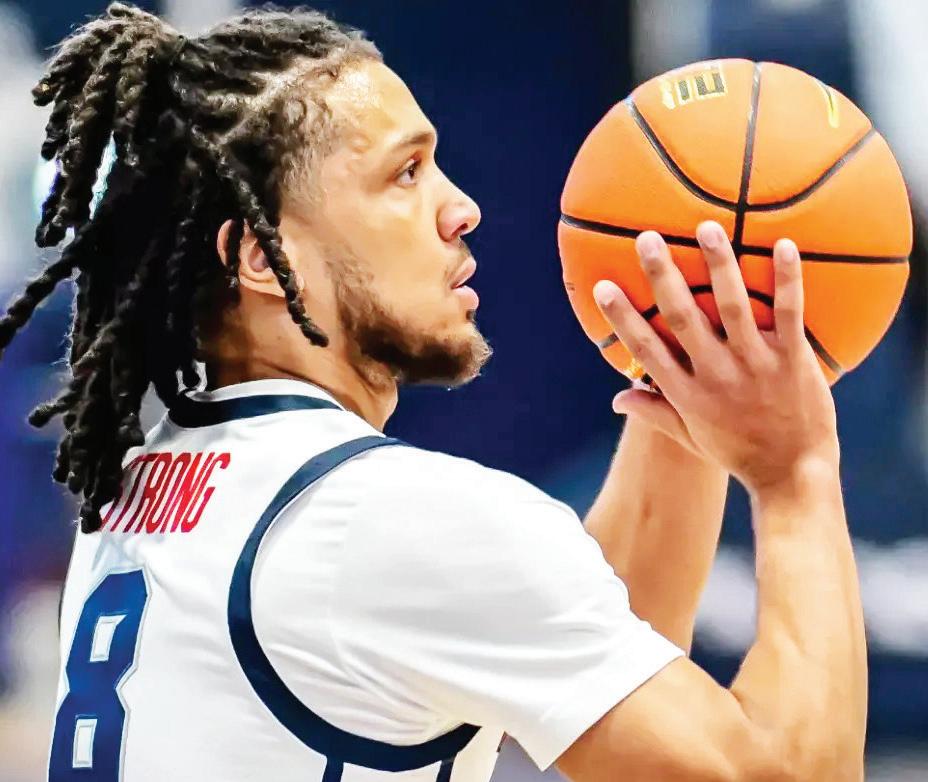
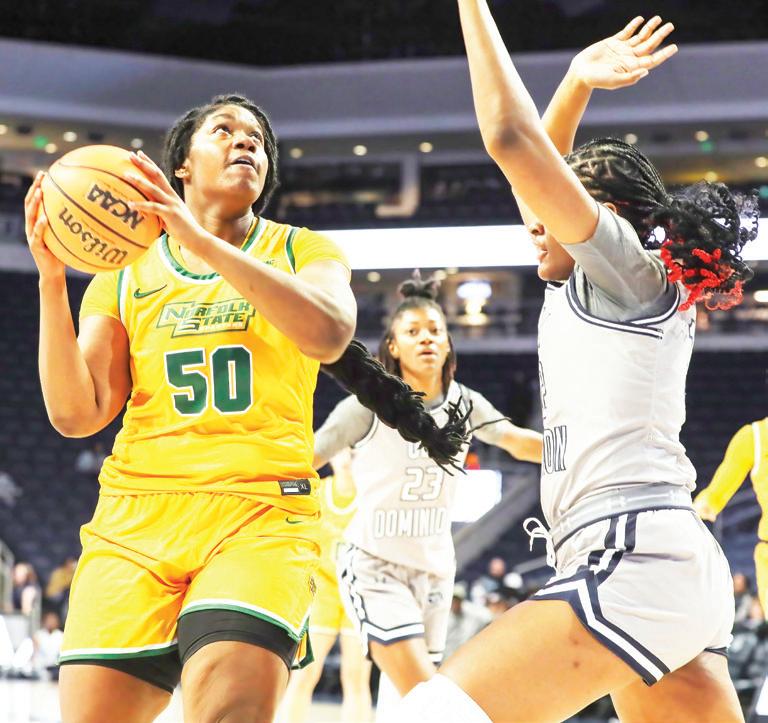
are essentially playing at home, the downtown Norfolk Scope Arena.
“I think playing at the Scope has its plusses and minuses… There also are distractions,” Norfolk State MBB Assistant Coach Gilbert Brown told reporters, including the MSR, during the March 5 bi-weekly basketball coaches video conference.
Added Vickers, “I think there’s the most beneficial part of it not having to travel. The thing about being in Norfolk is my team goes to classes — they don’t give us MEAC tournament off.”
Two Minneapolis natives are in this year’s tournament: Norfolk State’s Kierra Wheeler and Howard’s Joshua Strong.
Wheeler this season has garnered six Defensive Player of the Week honors and multiple times is listed among the league’s weekly top
■ See MEAC on page 9
sanmi scored 16 of his gamehigh 24 points in the first half, leading Tartan to an 8461 win over East Ridge High School in the Class 4A Section 4 semifinals. Check out the pics!
to mcdeezy05@ gmail.com.
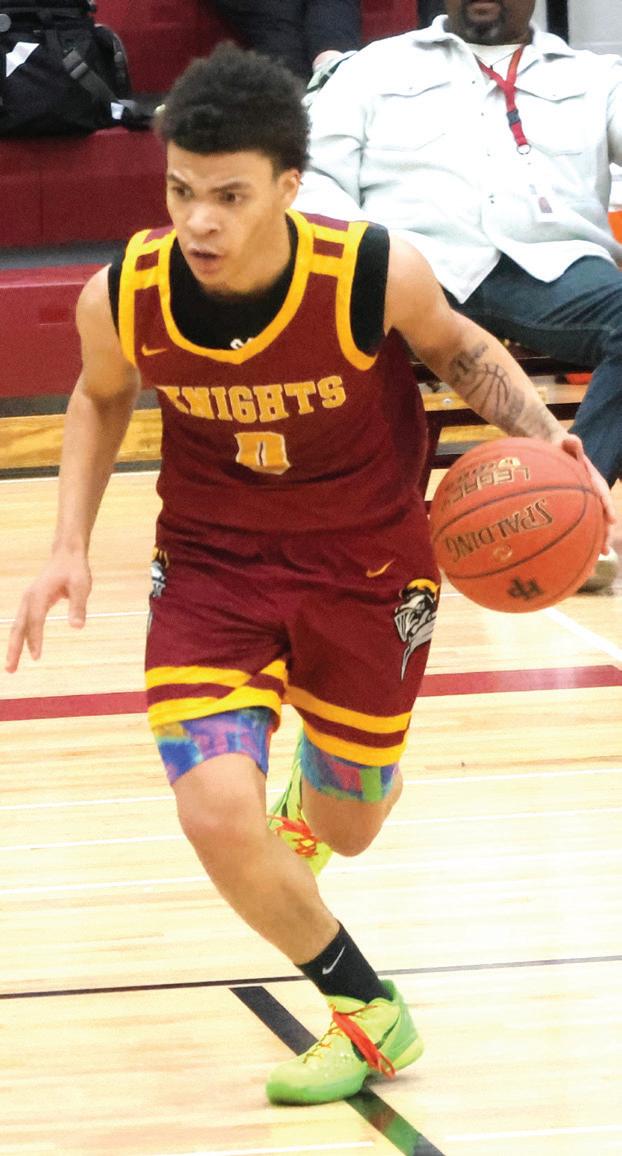
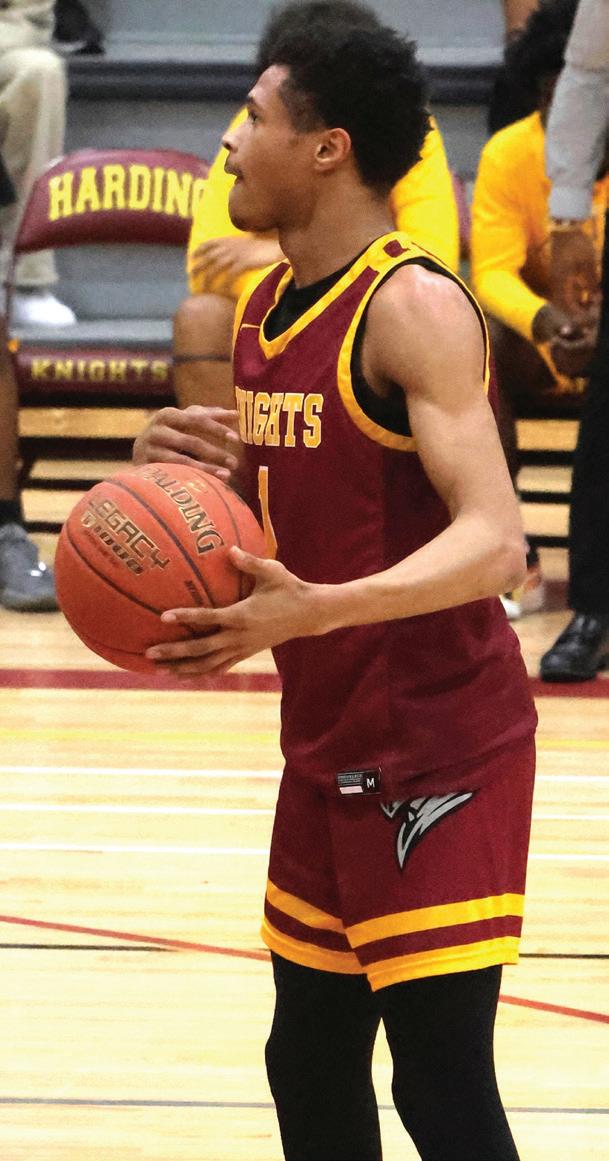
This occasional series will highlight Black coaches at all levels of sport. This week and next: the coaches of the HBCU Athletic Conference.
he HBCU Athletic Conference (HBCUAC) is the NAIA’s only all-Black conference. At its recent postseason tournament in Tuscaloosa, Al, we talked to a head women’s basketball coach and this year’s assistant basketball coach of the year winners.
Fisk coach says HBCUs exceptional, needed
Fisk (TN) University Head Women’s Basketball Coach Victoria Crawford was honored with the Community Impact Award for her support of the community, one of several Black women who were honored at this year’s tournament for their leadership and excellence.
Crawford, a Birmingham, AL native, has quite a distinguished basketball career both as a player (where she led the state of Alabama in scoring
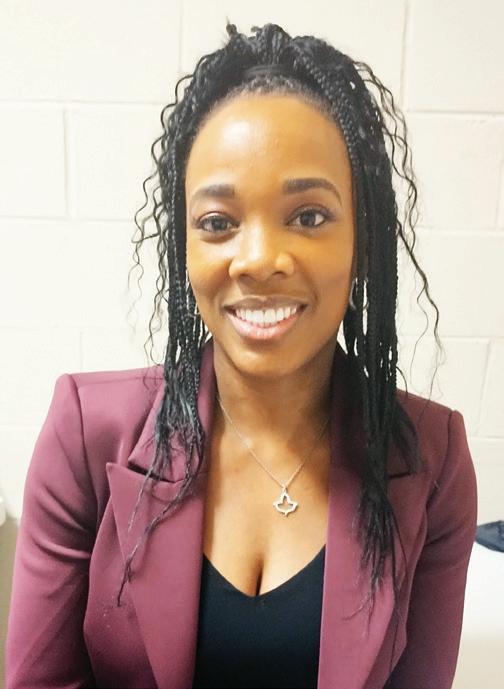
with a 27-point average as a high school senior), University of Memphis (where she was the 2004 Conference USA Sixth Player of the Year), and professionally overseas (2005 to 2010). And now as a veteran coach. She was the associate head coach at Miles College, and Southern Mississippi assistant coach, before getting her first head coaching opportunity at Lawson State (AL) Community College in her hometown. Her second opportunity came at now-defunct Lincoln (IL) College.
Fisk offered Crawford her third HC opportunity when she was hired in May 2022, and she just completed her third season at the Black college.
“This is a true conference tournament,” Crawford told us after her team’s first-round victory.
The head coach also is known for her dedication to teaching and coaching females. “My young ladies that I am so privileged to coach, that generation gives me hope,” said Crawford. “They’re future doctors, future lawyers, some are future politicians.
“My young ladies that I am so privileged to coach, that generation gives me hope.”
“The HBCU lifestyle is exceptional and needed, and it’s wanted,” said the Fisk coach on the current political climate. “As much as [others] are going to try to do away with it, it is not going